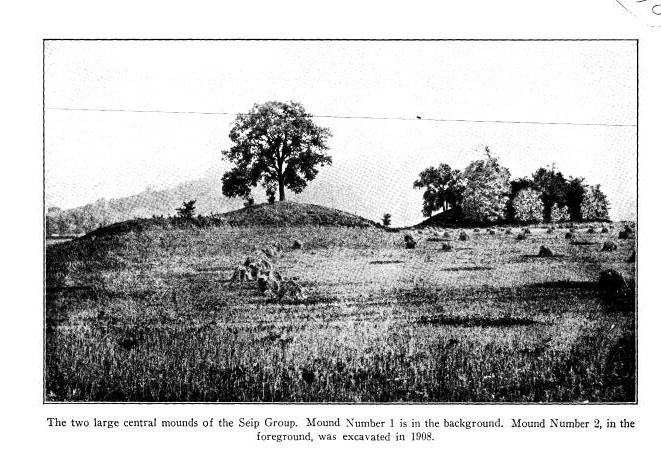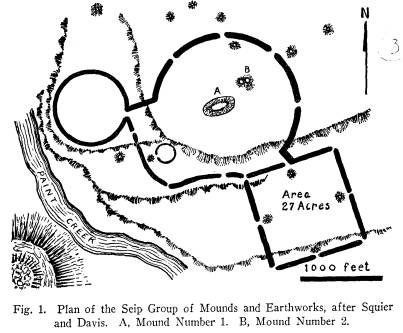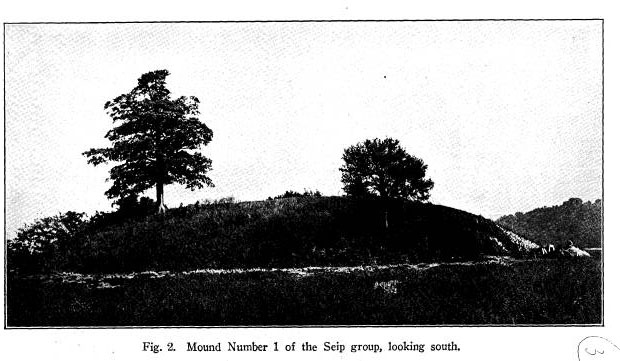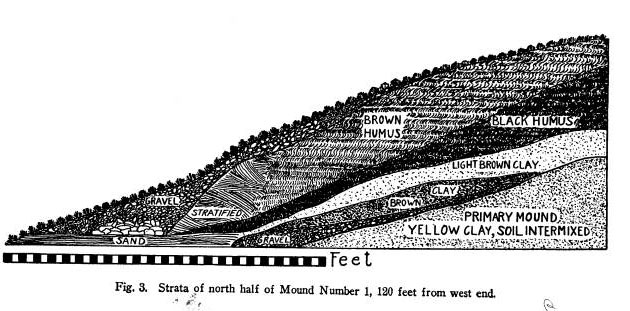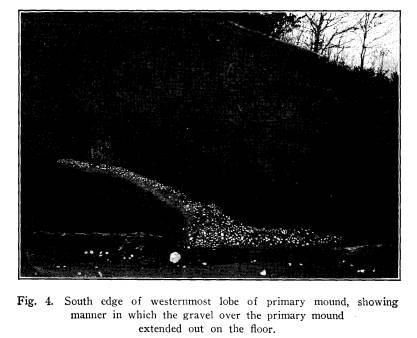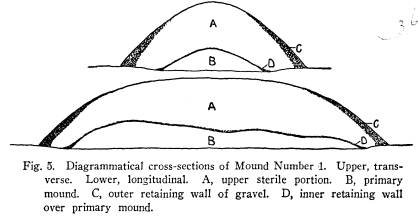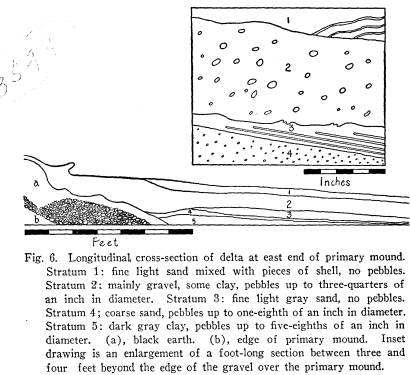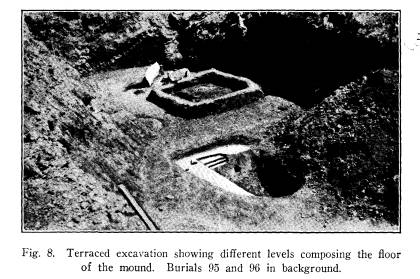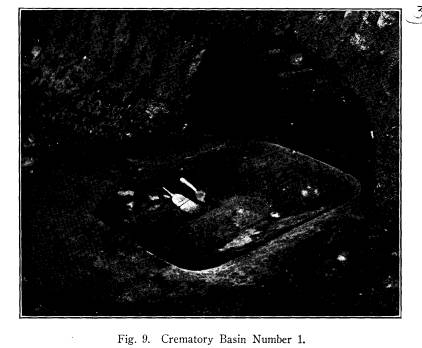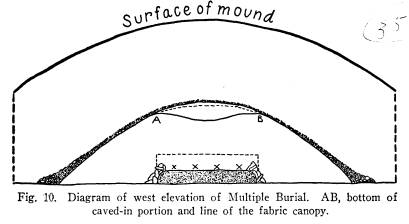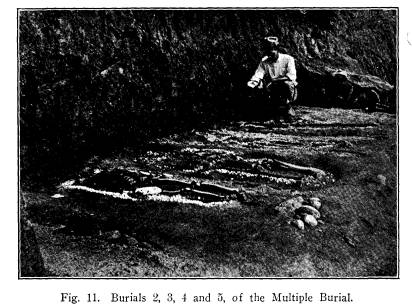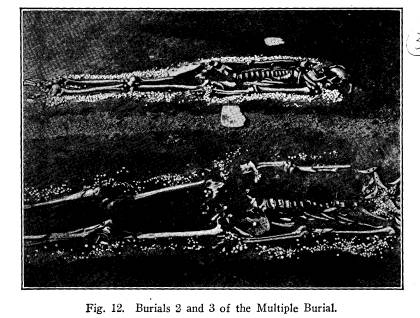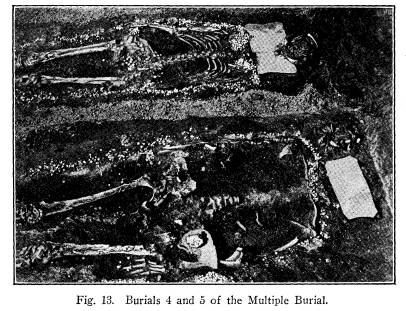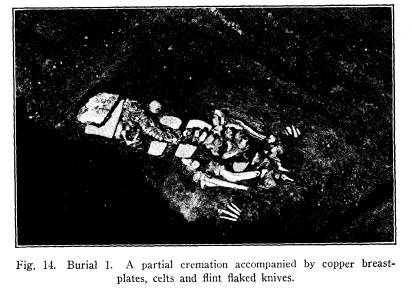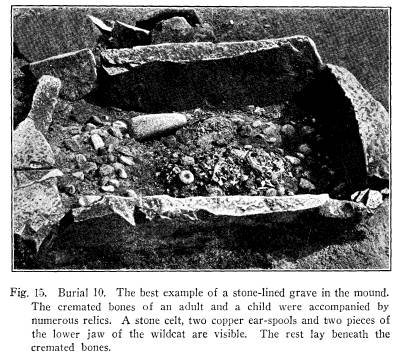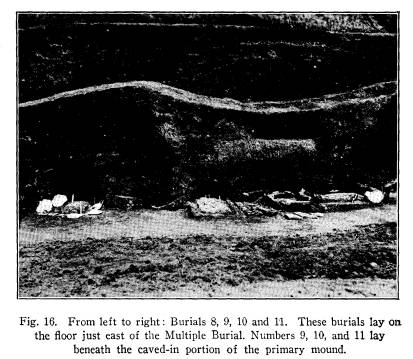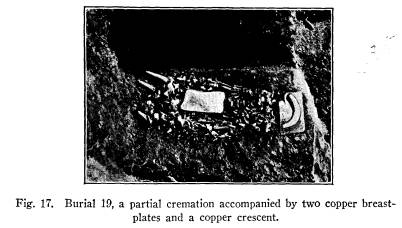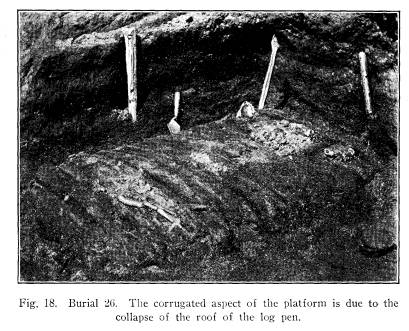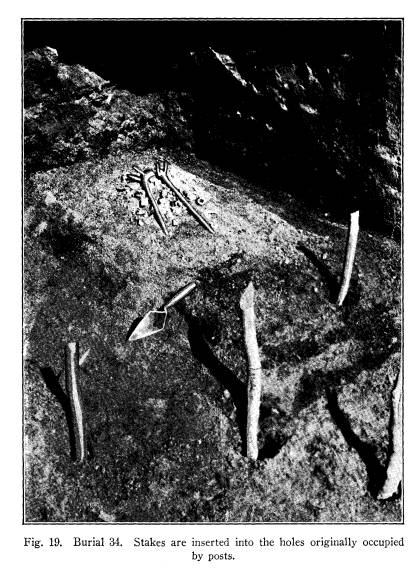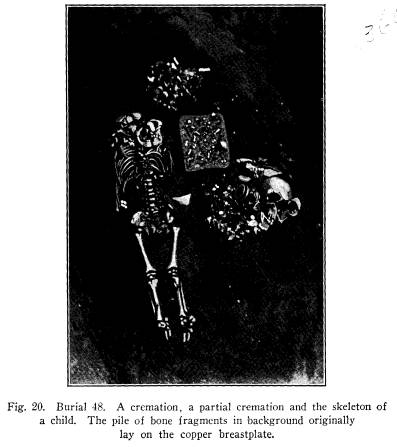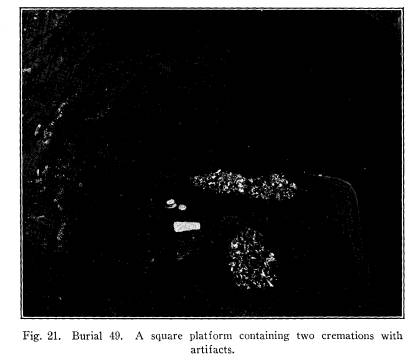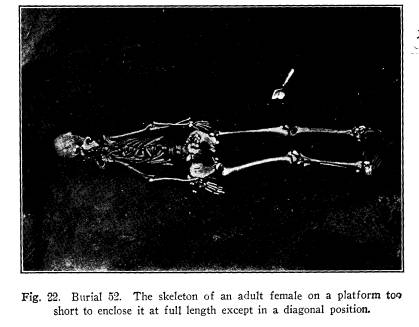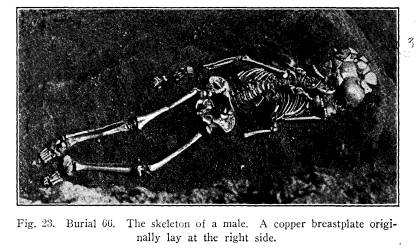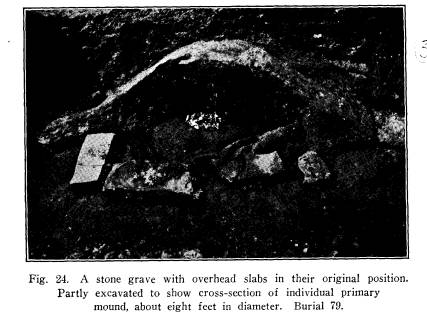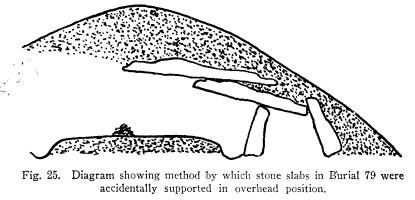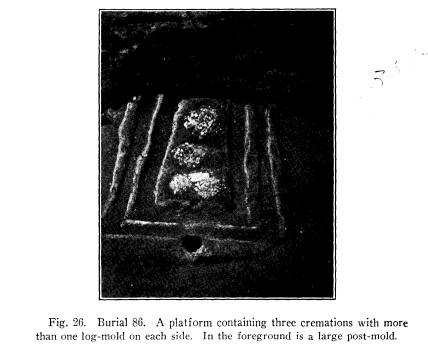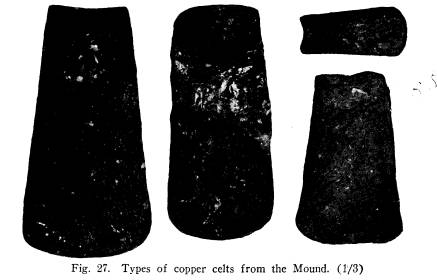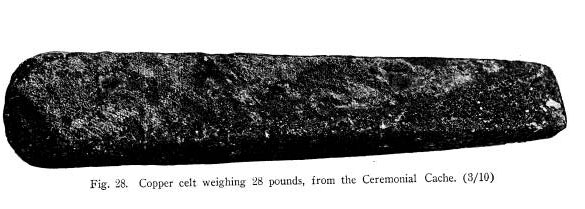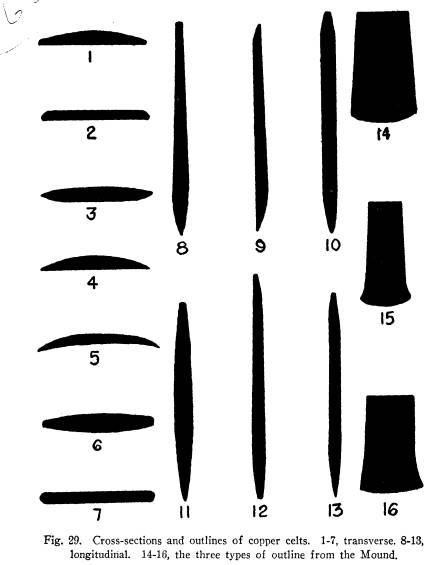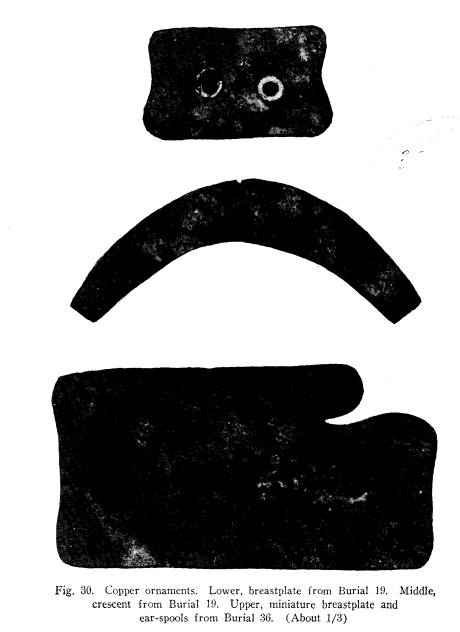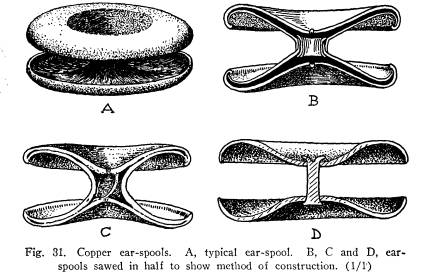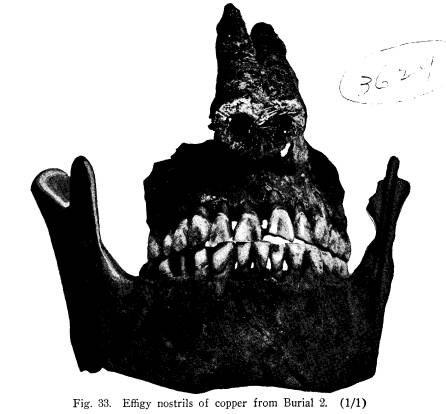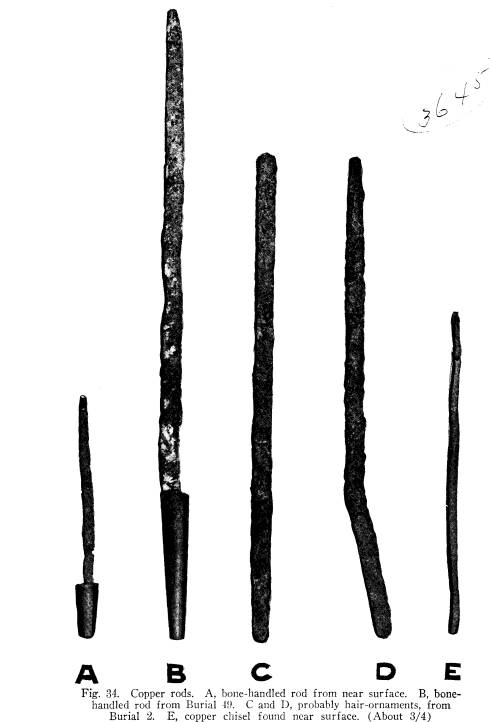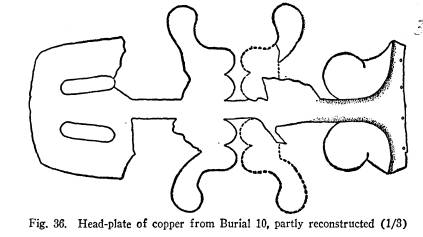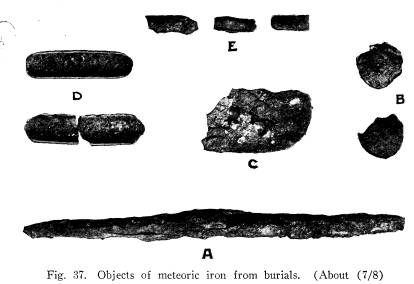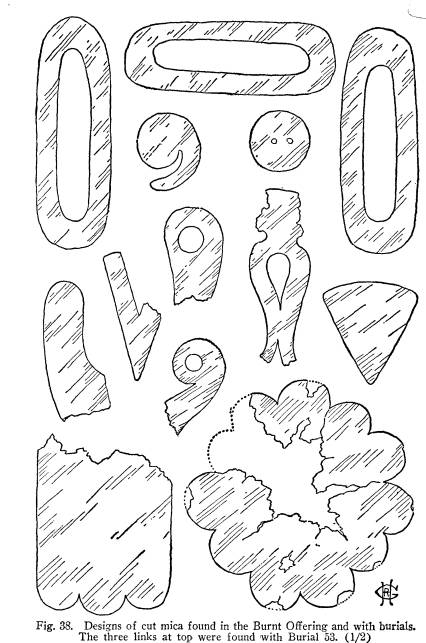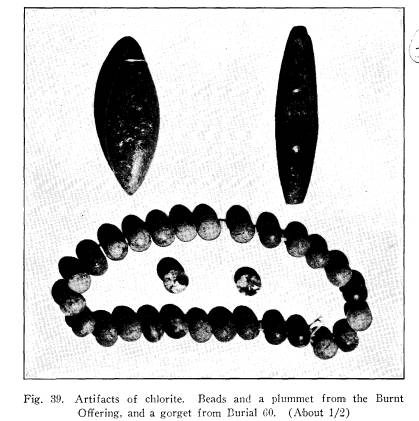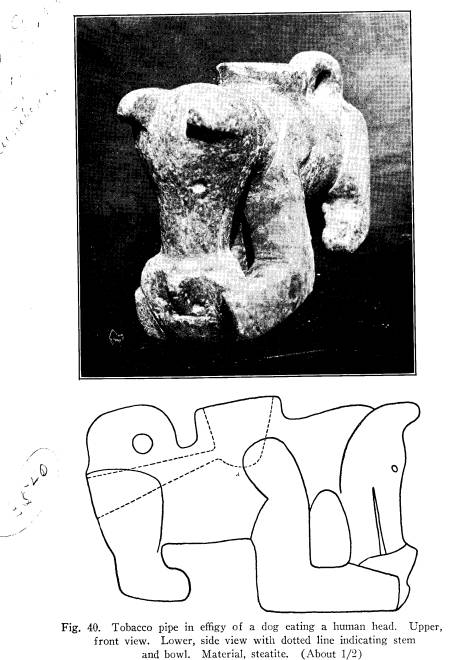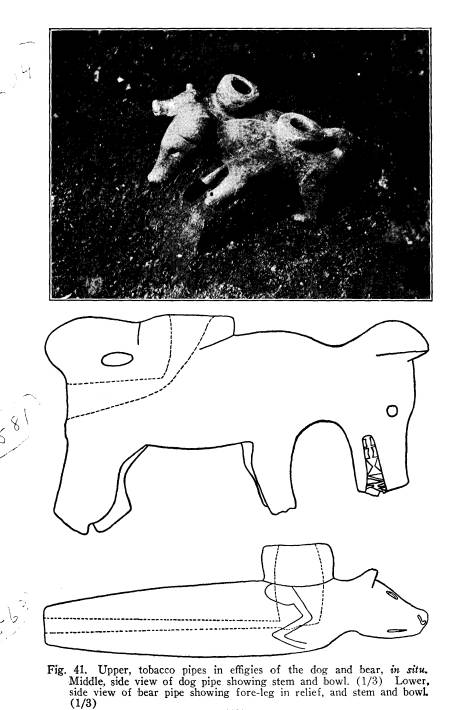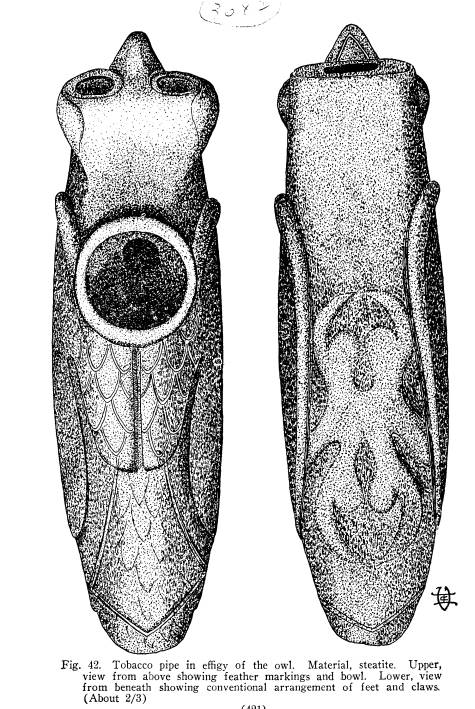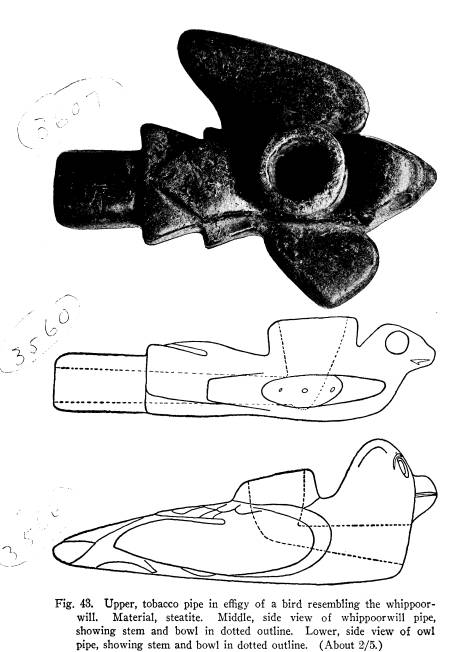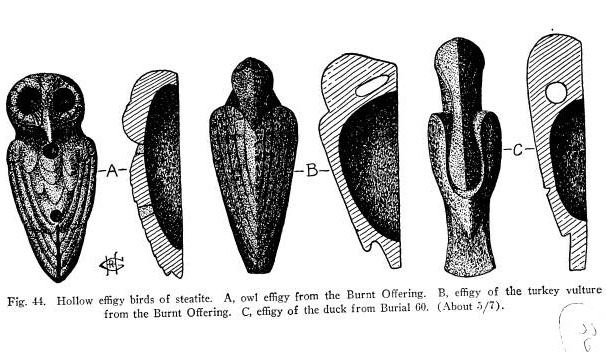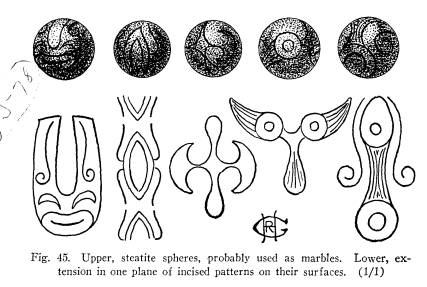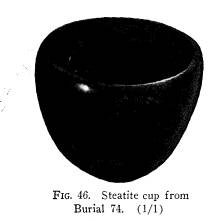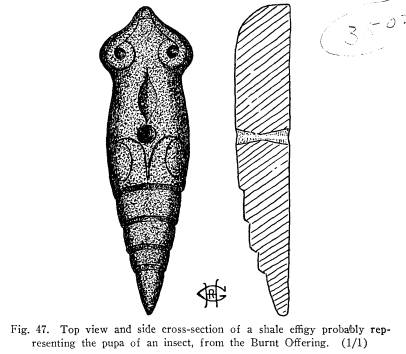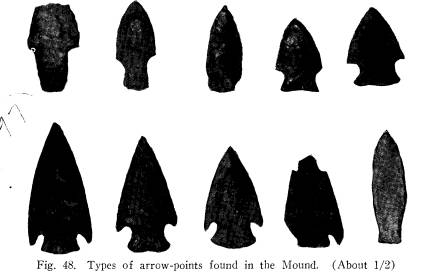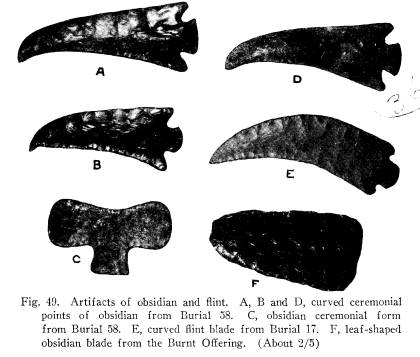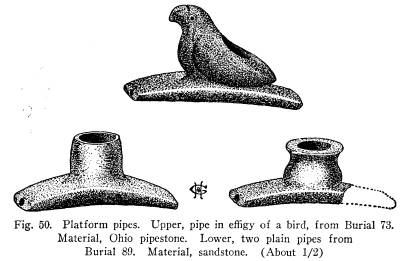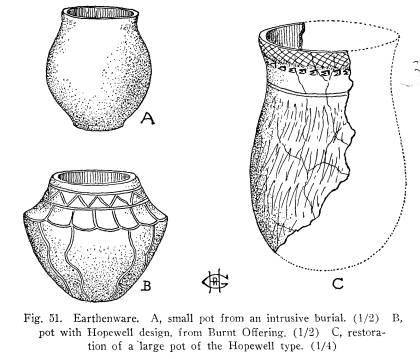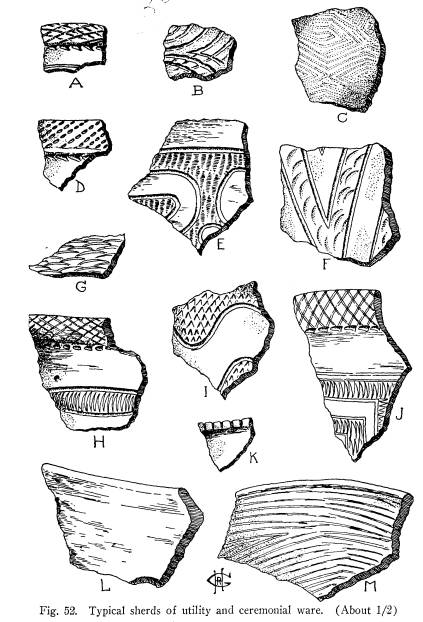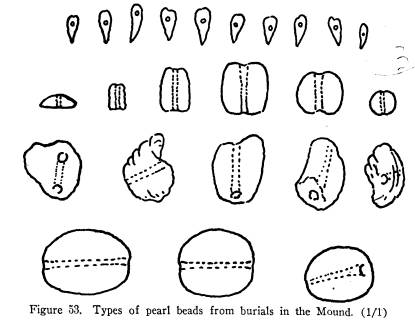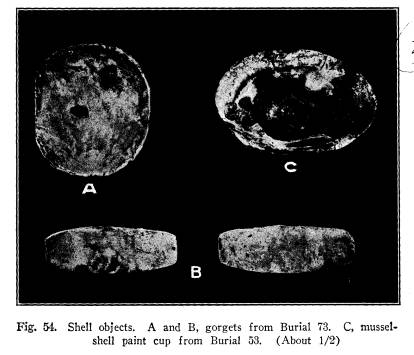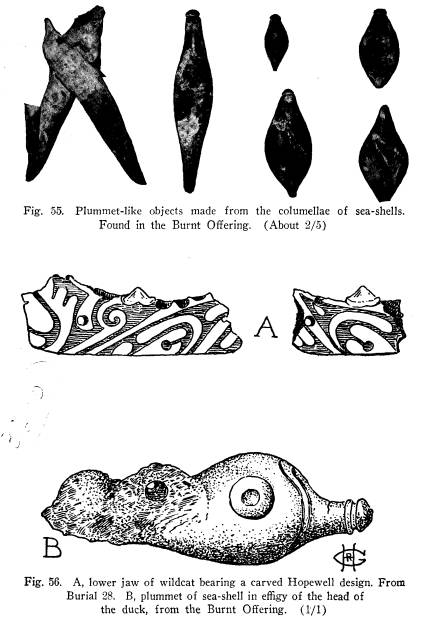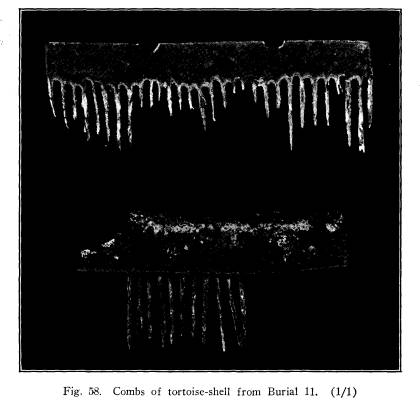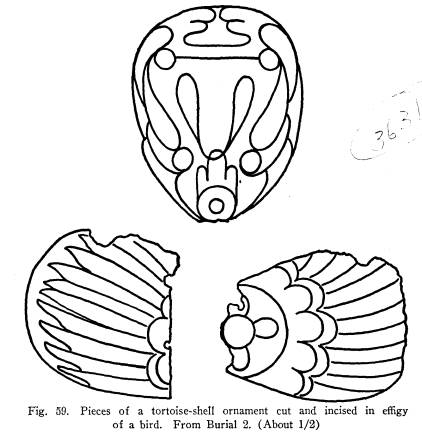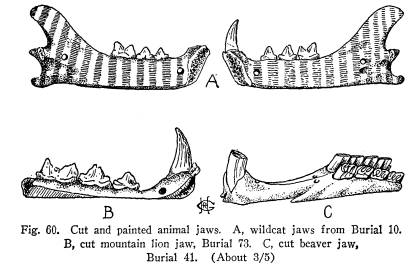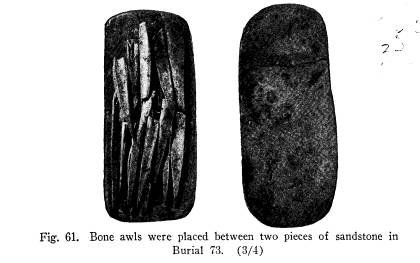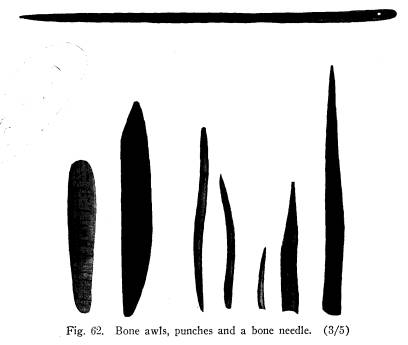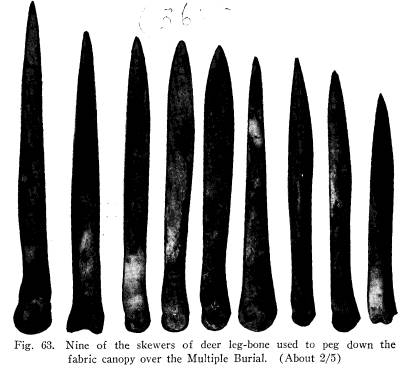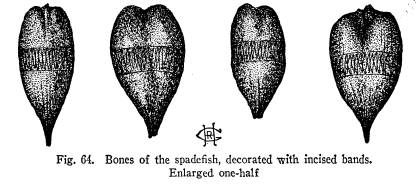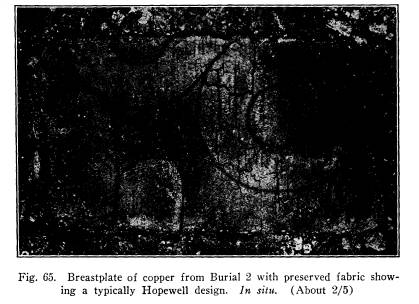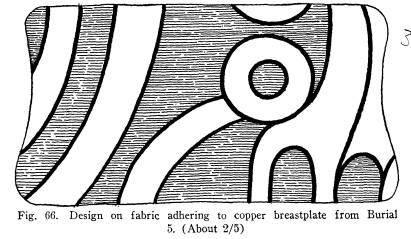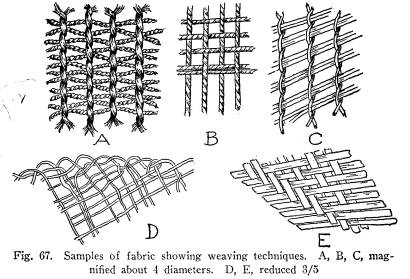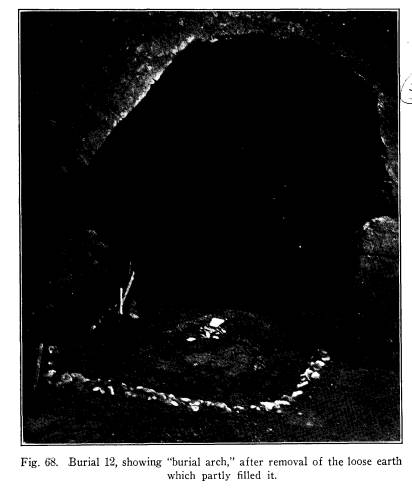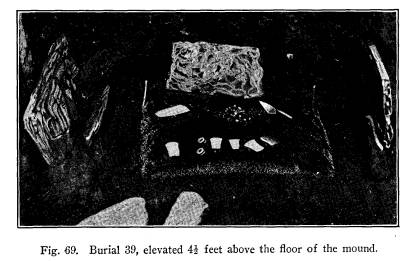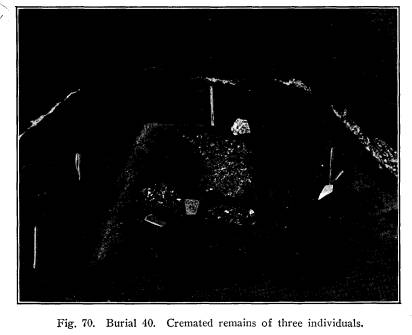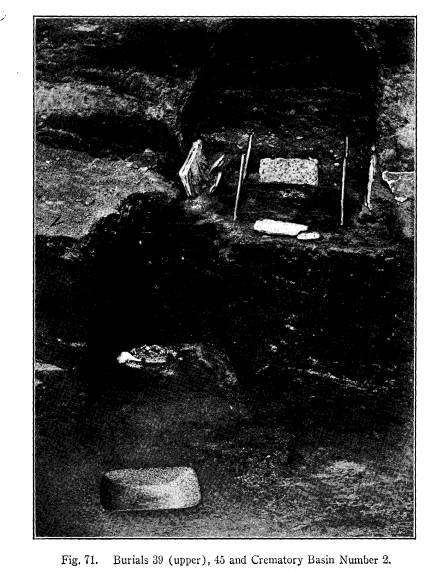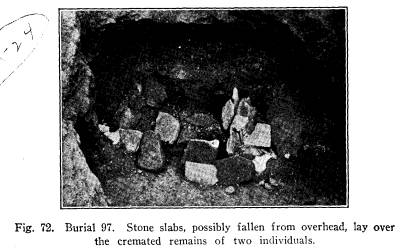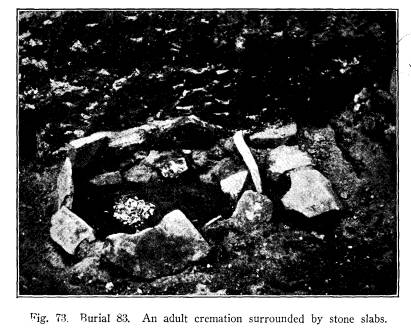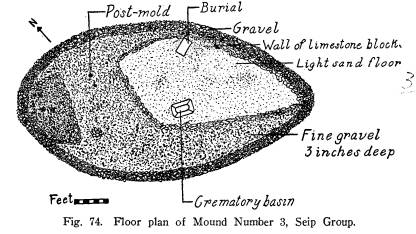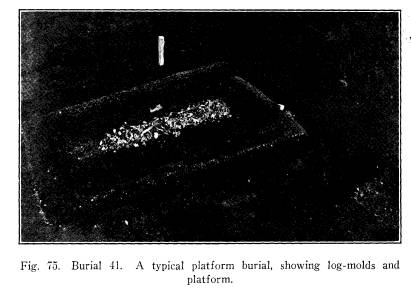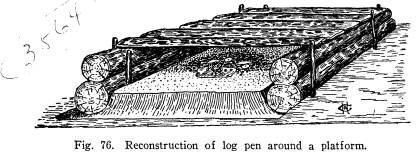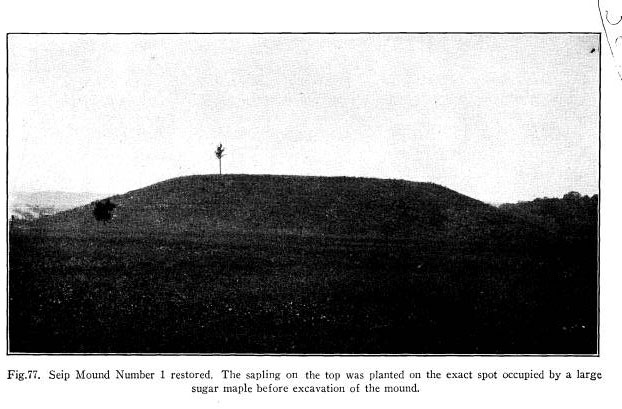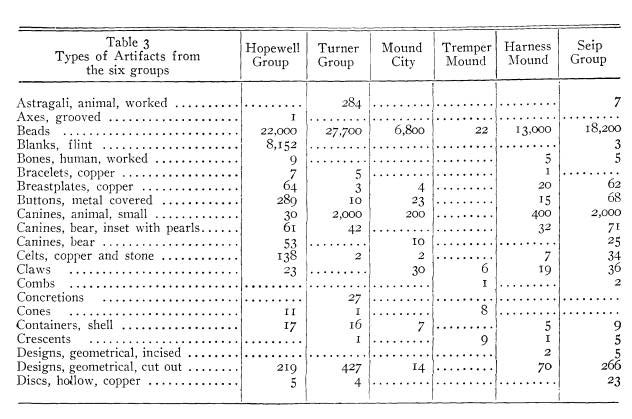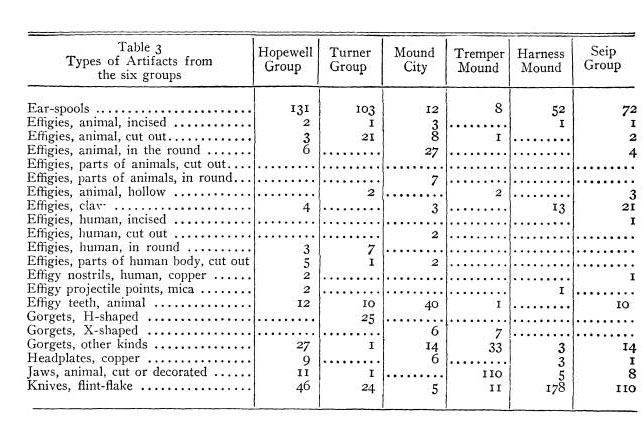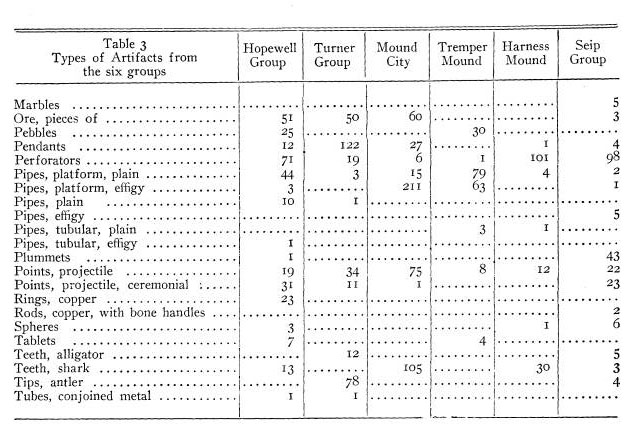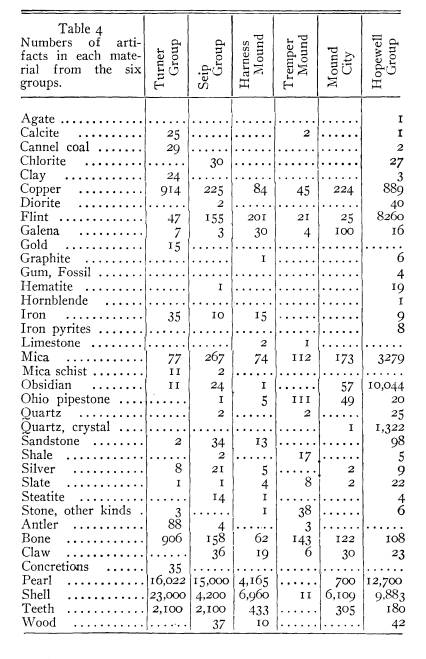Ohio History Journal
EXPLORATIONS OF THE SEIP GROUP OF PRE-
HISTORIC EARTHWORKS
BY HENRY C. SHETRONE AND EMERSON F.
GREENMAN
CONTENTS
Prefatory Note
Introductory
The Earthworks in General
Structural Aspects of the Central Mound
The Primary Mound
The Retaining Walls
The Floor
Crematory Basins, Depressions, Pits and
Post-molds
Burial Platforms
Burials and Deposits of Major Interest
The Great Multiple Burial (Burials 2-7)
The Burnt Offering
The Ceremonial Cache
Burials 1, 10, 19, 26, 28, 32, 34,42, 48, 49, 52, 58, 60, 66,
73, 79, 86.
Description of Artifacts
Inorganic Materials
Organic Materials
Complete list of Artifacts from Seip
Mound Number 1
Other Burials of Mound Number 1
Burials 9, 11, 12, 14, 17, 22, 23, 24, 27, 33,
35, 36, 37, 38,
39, 40, 41, 43, 45, 46, 53, 57, 59,
61, 63, 64, 65, 67, 68, 71,
74, 81, 85, 88, 89, 90, 97, 98
Intrusive Burials
Grave south of Mound Number 1
Burials without Artifacts
Burials 8, 13, 15, 16, 18, 20, 21, 25, 29,
30, 31, 44, 47,
50, 51, 54, 55, 56, 62, 69, 70, 72, 75,
76, 77, 78, 80, 82,
83, 84, 87, 91, 92, 93, 94, 95, 96, 99,
100.
Mound Number 3
Mound Number 4
Analysis of Burial Practices
Conclusions
Summary of the Hopewell Culture
(343)
PREFATORY NOTE
Examination of the Great Central
Tumulus of the
Seip Group occupied four successive
summers from
1925 to 1928. Headquarters were
established perma-
nently at the home of Mr. and Mrs.
Frank Zimmerman,
who occupied the Seip farm during the
entire period of
exploration. The mound itself is but an
eighth of a mile
distant from the farmhouse, which is
situated upon a
part of the remaining portion of the
great circle of the
Seip Group.
Henry C. Shetrone was in immediate
charge of ex-
cavation during the first three
seasons. Assisting him
during that period were Robert
Redfield, of the Uni-
versity of Chicago; J. Arthur MacLean,
of the Toledo
Museum of Art; Frank M. Setzler, of
Ohio State Uni-
versity; Robert Goslin, of Lancaster,
Ohio; and Frank
C. Hibben of Cleveland. Upon the death
of Director
William C. Mills and the advancement of
Mr. Shetrone
to his position, explorations of the
fourth season were
concluded by Emerson F. Greenman, newly
appointed
Curator of Archaeology, with the
assistance of Robert
Goslin, Frank C. Hibben and Samuel T.
Orton, Jr.
Mr. John Seip of Chillicothe and the
members of his
family tendered constant assistance and
cooperation to
the Survey, and deeded to the Society that
part of the
eastern portion of the mound which was
situated upon
their property, together with
additional adjoining land
to provide space for continuation of a
roadway around
(345)
346
Ohio Arch. and Hist. Society Publications
the Mound. For this valuable service
the Society here-
with expresses its gratitude.
Mr. Albert C. Spetnagel and Mr. John
Blosser of
Chillicothe rendered valuable
assistance throughout the
four seasons of excavation and the
thanks of the Society
are tendered to them at this time.
In view of the fact that most students
of Ohio
archaeology are familiar with the
details of the subject,
from previous reports on the Society's
explorations, and
in this particular instance from that
of Dr. William C.
Mills on the examination of Seip Mound
number 2, it
is deemed unnecessary to inflict upon
the reader of the
present report the minutiae of the
investigation con-
tained in the Survey's field
notes. These of course
are available to those who may be interested in them.
EXPLORATIONS OF THE SEIP GROUP
OF PREHISTORIC EARTHWORKS
BY HENRY C. SHETRONE AND EMERSON F.
GREENMAN
INTRODUCTORY
For the benefit of those readers who
may not have
found time and opportunity to acquaint
themselves with
the fundamentals of Ohio archaeology,
this brief outline
of the mound-building peoples of the
State is offered.
Throughout the valleys of the lower
Mississippi and
the Ohio rivers, together with many of
their tributaries
and adjacent territory, there have been
observed pre-
historic mounds and earthworks,
popularly attributed
to the so-called Mound-builders.
Exploration of these
tumuli and study of their burials and
relics show that
they were constructed, not by a
separate and distinct
race of people, but by various tribes
and nations of
American Indians. In a word, the trait
of building
mounds as monuments to the dead and of
constructing
earthworks for religious, social and
defensive purposes,
was almost world-wide among primitive
peoples, and
the native American Indians were no
exception.
Within the confines of the State of
Ohio three or
more kinds or cultures of prehistoric
inhabitants had
developed the trait of mound-building.
Two of these
are of foremost importance. The people
of the so-called
Fort Ancient culture were wide-spread
and numerous
(349)
350
Ohio Arch. and Hist. Society Publications
and left behind them extensive village
sites. Those of
the Hopewell culture, the most highly
developed of all
the mound-building peoples, were
responsible for the
erection of a score or more of great
geometric earth-
works and accompanying mound groups,
throughout
southern Ohio and contiguous territory.
Lack of space precludes mention of more
than a few
of the outstanding characteristics of
this and other cul-
tures of the State. Origin, antiquity
and disappearance
are perhaps the three phases of the
subject concerning
which information most often is
desired. As indicated
above, the mound-building peoples
belonged to the native
American race, so that the question as to
their origin
becomes a part of the broader question
as to the origin
of the American Indian. Most persons
are aware that
scientific opinion now inclines
strongly toward Asia as
the place of such origin.
While it is a recorded fact that in
certain sections of
the country mounds have been built and
used within
historic times, there is no evidence of
contact between
the builders of Ohio mounds and white
men; however,
there is no reason to believe that the
building of mounds
in the Ohio area may not have prevailed
well up to the
time of the appearance of Europeans in
the territory.
The question of antiquity of the
mounds, therefore, can-
not be specifically answered, since a
given mound might
be not more than two or three centuries
old while an-
other may have witnessed the lapse of
ten or twenty
centuries.
There appears to be but a single
historical incident
having a possible bearing upon the
disappearance from
Ohio of the mound-building cultures:
namely, the so-
Explorations of the Seip Group 351
called Iroquoian invasion, which
occurred about the
year 1650. While the mound-building
trait in the terri-
tory in question obviously had reached
and passed its
greatest development by that time,
there is reason for
believing that it may not have been
entirely obsolete, in
which case the Iroquoian conquest is a
conceivable factor
in its extermination. Other possible
causes are those
which have obtained throughout the
history of human
society--social and physical decadence,
famine and pesti-
lence, conquest and resultant
assimilation or even anni-
hilation. Archaeologists continue the search for evi-
dence that may link the mound-building
peoples with one
or another of several historic
cultures, but in so far as
the Hopewell culture is concerned there
appears to be
little to indicate affinity with
another stock.
The known facts with respect to these
questions may
be found in the various publications of
the Ohio Ar-
chaeological and Historical Society,
particularly in the
Archaeological History of Ohio, by Gerard Fowke. A
comparative study of the several
cultures is contained
in a paper entitled "The Culture
Problem in Ohio Ar-
chaeology," by H. C. Shetrone,
published in the Ameri-
can Anthropologist, (N. S.), Volume XXII, 1920. A
more recent study by the same authority
is The Mound
Builders, embracing the various mound-cultures of
North America, published in 1930 by D.
Appleton & Co.,
New York.
NOTE: The foregoing is reprinted from
"Explorations of
the Hopewell Group," by H. C.
Shetrone, Ohio Archaeological
and Historical Publications, Volume XXXV, 1926.
352 Ohio Arch. and Hist. Society Publications
THE EARTHWORKS IN GENERAL
The Seip Group of mounds and earthworks
is situ-
ated 17 miles southwest of the city of
Chillicothe, Ross
County, about at the center of a large
bend of Paint
Creek. At low water this stream has an
average width
of 70 feet. Its valley, nearly a mile
wide at the point
selected by the builders, is bordered
by hills many of
which attain an elevation of 500 feet
above the creek.
This rugged topography covers southern
Ohio and is
part of the foothill system of the
Appalachian Moun-
tains. The Seip Group is within 12
miles of the north-
ern limit of these foothills.
Ross County contains a known total of
455 aborig-
inal earthworks,1 a larger number than is credited to any
other county in the State of Ohio. In
the immediate
vicinity of the Seip Group are the Baum
Group of
mounds and geometrical earthworks and
Baum village
site, some three miles northeast in the
valley of Paint
Creek; Spruce Hill Fort, a defensive
inclosure of stone
covering the point of a hill which
projects into the val-
ley of the Creek from the south; a
conical mound 15
feet high four miles to the southwest;
a square inclosure
on the opposite (west) side of Paint
Creek, and a minor
system of earthen circles and walls on
the edge of the
town of Bainbridge, three miles
southwest. There are
in addition a score or more of small
burial-mounds
within four miles up and down the
valley.
According to the Squier and Davis map
(Figure 1),
there were originally four mounds and a
small circle
within the great circle of the Seip
Group. During exca-
1 Mills, William C., Archaeological
Atlas of Ohio, page 71.
|
Explorations of the Seip Group 353 vation of the great central mound two small mounds not listed by Squier and Davis were discovered within the great circle west of the central mound. They were ex- cavated and are described in this report as Numbers 3 and 4. The two small mounds and the small circle noted on the Squier and Davis map all have been destroyed by cultivation. |
|
|
|
Of the remaining mounds the largest lies at the cen- ter of the circular inclosure on a terrace about 15 feet above the low-water level of Paint Creek. The next largest mound of the group, about 200 feet to the northeast, was excavated by Dr. William C. Mills dur- ing the seasons of 1906 and 1908. In the report upon Vol. XL--23. |
354
Ohio Arch. and Hist. Society Publications
these excavations2 this mound was
called "The Seip
Mound," as it lay upon land
belonging to the Seip fam-
ily of Chillicothe. The central and
largest mound, with
all but the eastern 40 feet lying upon
the Pricer farm,
was referred to as "The Pricer
Mound," from the name
of the owner of that farm at the time.
In the present
report the great central mound is
designated as Seip
Mound Number 1, while the mound
excavated by Dr.
Mills will be called Seip Mound Number
2.
The report on Seip Mound Number 2 by
Dr. Mills
contains a description of the group as
a whole and in-
cludes abstracts from the accounts of
the early ar-
chaeologists, Caleb Atwater and Messrs.
Squier and Da-
vis who became familiar with the group
during the fore-
part of the nineteenth centruy.
The walls of the earthworks, with the
exception of
about 100 feet on the north, have been
almost entirely
obliterated. This surviving portion,
which can only be
traced by the experienced eye, is a
part of the larger
circle and owes its preservation to the
fact that it lies
within the farmyard beyond the reach of
plow and culti-
vator.
Seip Mound Number 1 is by far the
largest burial-
mound in the Paint Creek valley. The
long axis does
not lie due east and west, but in a
position pointing six
and one-half degrees north of east.
From end to end the
measurement was taken as 250 feet.
Owing to certain
low irregularities in the surface of
the ground, the edge
of the mound could not at all points be
determined accu-
2 Mills,
William C., "Explorations of the Seip Mound," Ohio Ar-
cheological and Historical Society
Publications, Volume XVIII, Columbus,
1909, page 269.
|
(355) |
356
Ohio Arch. and Hist. Society Publications
rately, and this measurement,
therefore, is correct only
within three or four feet. This is
unimportant however
since the dimensions of the essential
structural details,
the floor and the stone
circumvallation, were definite and
easily determined. The width of the
mound at center
was 150 feet. The greatest height, 32
feet, was main-
tained for a distance of 25 or 30 feet
parallel to the main
axis in a strip about ten feet wide on
top of the mound,
which therefore was approximately level
within this
area.
The work of excavation was begun on
August 10,
1925, and completed September 10, 1928.
Three subse-
quent seasons were occupied in
restoration of the mound
and about 200 feet of the circular wall
between the
mound and the highway. The site is now
a state park
ten acres in extent (Figure 77).
STRUCTURAL ASPECTS OF THE CENTRAL MOUND
The Primary Mound. Of first importance in under-
standing the structure of the interior
of the mound is
the fact that there was a primary or
original mound
consisting of three conjoined
lobes. This primary
mound was overlaid throughout its
entire extent by
a stratum of heavy gravel varying from
six inches to
two feet in thickness. Where this
stratum met the
floor of the mound it spread out to a
horizontal width
of eight or ten feet beyond the edges
of the primary
mound (Figures 3 and 4). This layer of
gravel on
the floor, the inner line of which
delimits the extent
of the primary mound, is shown on the
floor plan as the
second or inner circle of stones. The
outer ring is a
pavement of flat angular slabs of
sandstone and lime-
|
(357) |
|
358 Ohio Arch. and Hist. Society Publications stone. This pavement served as the base of the outer retaining wall of heavy gravel about ten feet thick at the bottom and extending with diminishing thickness three-quarters of the distance up the sides of the mound. A glance at the diagrammatical cross-sections of the mound, in Figure 5, will clarify the relative posi- tions of these strata in their vertical aspects. |
|
|
|
Of the three lobes of the primary mound the one at the west end was the largest. Its highest point was 17 1/2 feet above the floor. The north and south di- ameter was 88 feet; east and west, 108 feet. Lobe 2, next eastward was 11 feet high with an east and west diameter of 40 feet. Lobe 3, at the east end, was about |
|
Explorations of the Seip Group 359 eight feet high and had an east and west diameter of 25 feet. Above the primary mound the earth was practically void of intentionally placed burials, excepting the up- per four or five feet, just beneath the surface, where several intrusive burials were found. The earth of the primary mound had a considerable content of clay and was of a lighter brown than that of the overlying portion. The entire mound above the stratum of clay over the primary was built up of dark brown earth profusely intermixed with humus, char- |
|
|
|
coal and ashes and quantities of animal bones and other refuse material, including an occasional artifact. In view of the nature of the soil and of the artifacts found in it, this portion of the mound appears to have been removed from the surface in the immediate vicinity upon which the builders had lived. At the east end of the primary mound there was a delta about 30 feet long on the floor of the mound. This deposit of water-laid materials indicates a flow of |
|
360 Ohio Arch. and Hist. Society Publications water between the time of completion of this lobe of the primary and addition of the earth over it. Stratum 2 in Figure 6 represents the greatest volume of the flood, since it is the thickest of the five and contains the coarsest materials. The section shown in this drawing runs east and west and the direction of the flow of water, as indicated by the gradual tilt of the strata, was to the right or eastward. While this is also the direction of the flow of Paint Creek,3 it seems prob- |
|
|
|
3 Old residents of Paxton township tell of seeing the entire valley of Paint Creek flooded, and in the season of 1926, during excavation of the mound, the water came up to within a few inches of the level upon which the mound is situated. |
Explorations of the Seip Group 361
able that what is represented in this
delta is a cloudburst
which occurred at a time when the mound
was but par-
tially built, with an elevated area
acting as a catch-basin
and overflowing on the east end of the
mound.
In the 18-foot section in the drawing,
the gravel at
the bottom of the primary mound is
shown at the left
or west end, with the edge of the
primary mound indi-
cated as (b). Stratum (a), lying
directly over the gravel,
was composed of rich black earth. The
inserted draw-
ing represents a close-up view of a
foot-long section
three feet beyond the edge of the
gravel of the primary
mound. The wavy lines in Stratum 1 were
dark lenses
of sand about one-quarter of an inch
thick. The four
lenses in Stratum 3 were about
one-eighth of an inch
thick and were made up of reddish fine
sand. Only a
part of Stratum 4 is shown in the
insert and Stratum 5
is omitted.
The Retaining Walls. Both the primary mound
and the outer surface of the mound
proper were over-
laid with a heavy deposit of gravel
(Figure 5). The
purpose and manner of construction of
these retain-
ing walls were easily apparent. In
erecting both parts
of the mound, using ordinary soils and
clays, erosion
was a factor to be met and disposed of.
The builders
of the mound would have learned this
from the wash,
ing down of the materials of the delta
if from no
other source. Erection of the entire
mound took sev-
eral seasons at the least, and the
apparent function
of the retaining walls was to prevent
washing both by
flood and storm during this period. The
gravel wall
at the surface of the mound proper (C
in Fig. 5) was
362
Ohio Arch. and Hist. Society Publications
related only to that portion lying
outside and above
the primary mound. The gravel stratum
lying di-
rectly upon the primary mound (D in
Fig. 5) bore
the same relationship to the primary,
and differed
from the outer wall only in lacking a
base of flat stone
slabs. The erection of both of these
walls was probably
a continuous process with the piling up
of the earth
which they covered. For example, the
primary mound
was not first entirely completed and then
covered with
gravel, but the height of the gravel
stratum probably
was kept equal with that of the primary
mound to pre-
vent erosion. An effect, if not an
intended purpose of
the gravel over the primary, seems to
have been to keep
surface water from reaching the burials
on the floor.
The spaces between the gravelstones
were not complete-
ly filled with sand and it was apparent
that water, seep-
ing downward, had been deflected by
this gravel layer
down the sides of the primary to its
edges. Just above
this gravel layer was a stratum of
solid yellow clay. At
the top center of each lobe of the
primary this stratum
was from 28 to 32 inches in thickness,
tapering grad-
ually down to 12 inches at the
depressions where the
lobes joined one another and then disappearing
within
three or four feet of the edges of the
primary on the
floor. The upper line of this yellow
clay conformed to
the contour of the lobes and was
overlaid directly by the
mixed earth of the upper portion of the
mound.
The pavement of stone slabs forming the
base of
the outer retaining wall was on the
floor of the mound
at its outer margin. The slabs forming
this base were
not all laid flat, and there was a
tendency for those on
the outer edge to be in a perpendicular
position. This
Explorations of the Seip Group 363
pavement consisted for the most part of
blocks of sand-
stone ranging from six to 100 pounds in
weight. At
some points they were piled on top of
one another to a
height of a foot or two. Above this
base, forming a
retaining wall proper and conforming to
the slope of
the surface of the mound, heavy gravel
was piled. At
the base the thickness of this gravel
was generally the
same as that of the stone pavement
beneath, from eight
to ten feet; it decreased in thickness as
it extended up
the sides of the mound and disappeared
about 15 feet
from the apex excepting at certain
points where it con-
tinued over the top of the mound to
form a complete
covering. It is apparent that the
gravel originally cov-
ered the entire mound and was partly
washed down dur-
ing the centuries following its
erection. This retaining
wall was covered at all points by a
foot or two of earth
which was thicker at the base of the
mound than at the
top, where at some points the gravel
was at the surface.
There can be little doubt that the
height of this retain-
ing wall, like that over the primary,
was kept equal with
that of the earth above the primary as
it was built up,
to prevent undoing by the elements of
the arduous labor
of the builders. Doubtless the outer
retaining wall had
the same effect as that over the
primary in deflecting the
seepage of water, though to a lesser
degree, for the earth
of the upper part of the mound was less
compact than
the clay of the primary. The layer of
clay over the in-
ner retaining wall offered further
obstruction to the
downward course of surface water and
lessened the
amount which would reach the floor of
the mound.
The Floor. Before erection of the mound the sur-
face soil from the corresponding area
had been removed
364
Ohio Arch. and Hist. Society Publications
to a depth of from six to 12 inches.
This comparatively
level area was then covered with a
layer of dark clay or
muck varying from six inches to a foot
or more in depth.
It was firm in texture and throughout
as solid as a fre-
quently used path in clay soil. Certain
areas, moreover,
had been hardened by fire, which
colored the surface
and the underlying three or four inches
in reds, yellows
and browns. This hard-packed clay and
muck under-
laid the entire mound, becoming mixed
with the loose
surface soil of the site only beneath
the pavement of
stone slabs encircling the primary at
the edge of the
mound proper. The floor was the same
beneath all three
lobes of the primary, without a break
between one and
another. A lens of rather coarse
water-washed sand
lay upon the floor, varying in
thickness from a quarter
of an inch to an inch. While at times
this lens could
not be distinguished it probably
covered the entire area,
a characteristic and intentional
feature of Hopewell
floors.
The only constructions extending
beneath the floor-
level were the so-called crematory
basins; holes formerly
occupied by posts and stakes of wood,
which had de-
cayed; irregular depressions, apparently
prepared for
the reception of offerings of a special
nature; and pits
which contained refuse material, ashes
and charcoal.
Occasional areas were found where the
clay and
muck fill of the floor was two feet or
more in depth. A
view is shown in Figure 8 of one of
these areas near
the east end of the mound, after its
excavation in ter-
races showing the different levels. Six
levels were found
at this point, each separated from the
others by a very
thin lens, light brown in color, which
appeared to con-
|
Explorations of the Seip Group 365 sist partly of weathered vegetable matter. These extra thick fills of clay apparently were supplied to fill depres- sions in the natural surface. Beneath the floor was the coarse clay and gravel subsoil characteristic of the general region. Crematory Basins, Depressions, Pits and Post molds. There were five of the so-called crematory basins. These are rectangular receptacles in the floor of the |
|
|
|
mound, generally with rounded corners, sides sloping inward and downward to a flat base, and having a depth of less than a foot.4 They are usually very carefully prepared from clay and are symmetrical and smooth on the surface of the sides and bottom. They are al- 4 Dimensions of Crematory Basin Number 1: 36 by 47 inches, five and one-half inches deep. Number 2: 19 by 26 inches, four inches deep. Num- ber 3: 27 by 38 inches, five inches deep. Number 4: 29 by 41 inches, seven inches deep. Number 5: 26 by 40 inches, five inches deep. |
366
Ohio Arch. and Hist. Society Publications
ways baked to a degree of hardness
about that of the
utility type of pottery found in the
mounds. The clay
is generally a coating not more than
three inches
thick, lying in and exactly conforming
to a corresponding
depression in the hard-baked mixture of
muck and gravel
forming the floor. As the name
indicates, it is believed
that these basins were connected with
the process of
cremation, but in just what manner is
not understood.
Their surfaces are usually colored
bright red or yellow
by the action of heat, supposedly
incidental to cremation.
While they are generally devoid of
contents, cremated
remains and artifacts have been found
in them. By some
early writers they were termed
"altars."
Crematory Basin Number 1 was very
symmetrical
and carefully made. It was filled to
the brim with clean
charcoal, mostly portions of limbs and
twigs up to one
and one-half inches in diameter, which
had apparently
been burned in situ. Mixed with
the charcoal were
numerous shell and pearl beads and 30
canine teeth of
the bear, both the native black bear
and the grizzly.
These teeth were perforated in the
usual manner and
several were set with pearls. All
artifacts were badly
burnt.
Crematory Basin Number 2 was the
smallest ever
found in Ohio. No artifacts were found
in it, but at the
southwest corner on the adjacent floor
was a mass of
charred grass and twigs covering about
a square yard,
in which were found fragments of woven
fabric and a
flint-flake knife. This basin, very
beautifully made,
was removed intact and taken to the
Museum.
Crematory Basins Numbers 3, 4 and 5
were devoid
of contents.
|
Explorations of the Seip Group 367 Depressions. One-hundred and thirty feet from the west end of the mound and about 40 feet south of center three small depressions in the floor were filled with charcoal, fragments of pottery and marine shells, mica and flint-flake knives of Flint Ridge material. The exact nature of these deposits is somewhat obscure. |
|
|
|
They were roughly circular, about a yard in diameter and from six to ten inches in depth. Probably they were ceremonial in nature, the artifacts contained in them having been symbolically "killed" by burning or break- ing them. A similar deposit containing fragments of obsidian spears occupied an oval area nine by five feet on the floor adjacent to the platforms of Burial 60. |
368 Ohio Arch. and Hist. Society Publications
Pits. Two pits, four feet apart, extended beneath
the floor just north of Burials 95 and
96, one of them
lying directly beneath Burial 93. Their
positions are
indicated on the floor plan. The
outline of Pit 1 can
be seen in the background in Figure 8.
It was 30 inches
in diameter and 25 inches deep. It
contained, mixed
with a fill of clay and gravel, a flint
flake, a few pot-
sherds and two pieces of animal bone.
Pit Number 2
was 27 inches in diameter and 30 inches
deep, and con-
tained a quantity of potsherds. Another
pit containing
the remains of Burial 77 will be
described later.
Post-molds. The molds of more than 200 posts and
stakes were found in the floor of the
mound, usually
adjacent to platforms and occasionally
piercing them.
They varied in diameter from one to 15
inches and in
depth from two to four feet. The solid
mixture of clay
and muck comprising the floor preserved
the shape of
these posts and in some instances even
the impressions
of the bark. Plaster casts of several
revealed blunt,
crudely chopped ends which were not
sufficiently pointed
to admit driving the posts into the
ground by the use of
mauls. The builders of the mound must
first have dug
holes for the posts and then packed the
dirt around
them. One post at the southwest corner
of the platform
of Burial 43, 11 inches in diameter,
was held in position
by several split stakes wedged in
around it at the ground
level. Most of these post-molds
extended above the
floor to a height not ascertainable
since the loose earth
of the mound had given way in every
instance. There
were large post-molds at each corner of
the platforms
of Burials 39 and 50, the only two
instances of orienta-
tion or symmetrical arrangement. While
these may
Explorations of the Seip Group 369
have been the remains of the support
for structures, the
greater majority of the post-molds,
particularly those
in or adjacent to burial platforms,
appear to be the re-
mains of posts upon which trophies or
tributes to the
dead were hung, before erection of the
primary mound.
This practice prevailed among certain
aboriginal groups
in historic times.5 The smaller holes
were the remains
of stakes which supported the timbers
of the log cribs
around the burial platforms.
Burial Platforms. The great majority of burials
were on small platforms built up a few
inches above the
floor, of clay, sand, charcoal and
occasionally of gravel.
With one exception these platforms were
quadrilateral
and all were bordered by the imprints
of horizontal logs
in one, two or three vertical tiers.
These log-molds were
the remains of small log cribs which
originally sur-
rounded the platforms, over which there
had been a roof
of logs or bark (See Figures 75 and
76). In several in-
stances the platforms were surrounded
by both log-
molds and angular blocks of stone
placed vertically in a
circle or rectangle. Covering the
original log cribs and
platforms were small individual primary
mounds two to
three feet in height, of sand or
gravel.
BURIALS AND DEPOSITS OF MAJOR INTEREST
The Great Multiple Burial. Six burials (Numbers 2
to 7 inclusive) were grouped together
in a specially con-
structed chamber of logs covered with a
canopy of
woven fabric. This chamber lay at the
west end of the
5 See "Native Cemeteries and Forms
of Burial East of the Mississippi,"
by David I. Bushnell, Jr. Bulletin
71, Bureau of American Ethnology,
Washington, 1920, pp. 24, 41.
Vol. XL--24.
370 Ohio Arch. and Hist.
Society Publications
western or largest lobe of the primary
mound, and at
the time of its discovery was
completely filled with earth
owing to a cave-in shortly after the
completion of the
primary mound over and around it. In
size, in the va-
riety of materials used in its
construction and in the
complicated nature of the structure,
this chamber ex-
ceeded all other inclosures around
burials in the entire
mound. This fact, together with the richness and
abundance of the artifacts which were
placed with the
burials, points to the conclusion that
the individuals here
represented were of extraordinary
importance in the
lives of those who built the mound.
All of these burials were inhumations, of
which there
were only 11 in the mound, excluding
the intrusive
burials. Of the six under discussion
four were the
skeletons of adults. These lay side by
side in the ex-
tended dorsal position, heads to the
east, on a level ele-
vation four feet above the floor of the
mound. The
skeletons of Burials 6 and 7, both
infants under one
year of age, lay just east of Burials 4
and 5.
The burial-chamber, originally
constructed perhaps
to keep the earth from crushing the six
skeletons, meas-
ured 12 feet east and west and 15 feet
north and south.
The height was indeterminable. The
chamber had been
constructed of logs placed above one
another and se-
cured in place by large stones, both
outside and inside;
most of the stones however were inside,
placed thus to
assist the logs in withstanding the
pressure of the earth
around the sides and from above. The
original vault
could not have been more than two feet
in height. The
evidence for this statement lies in the
interpretation
of the strata resulting from the
collapse of the roof
|
Explorations of the Seip Group 371 shortly after it was covered over by the builders with the earth of the primary mound. In the diagram in Figure 10 the 1ine AB represents the fabric canopy which rested upon the primary mound immediately over the vault. (See also Fig. 16). The dotted line just above is the probable surface of the primary be- fore it caved in and immediately overhead is the thin gravel layer over the surface of the primary as it was |
|
|
|
rebuilt, that is, as the depression due to the cave-in was filled. Since the distance from the bottom of the sag to the top of the reconstructed primary was two feet, the height of the hollow space within the vault could have been no more. The crosses on the surface of the plat- form at the base of the primary indicate Burials 2, 3, 4 and 5. The dotted line over them indicates the prob- able position of the roof and sides of the log structure which formerly surrounded the platform and inclosed the burials. It is interesting to note that a second can- opy of woven fabric was not placed over the rebuilt crest of the primary. |
372 Ohio Arch. and Hist.
Society Publications
The canopy, perhaps intended as a
ceremonial
shroud, was secured in place by a
hundred or more bone
skewers, embedded peglike through the
fabric to their
heads. One of them had been broken in
penetrating
the earth. The broken piece, about two
inches of the
"handle" end, still attached
to the rest by strands, lay
horizontally on the fabric line. These
skewers or pegs
were from six to 12 inches long and
were made of the
leg-bones of the deer (Figure 63).
Where the canopy terminated at the
surface of the
primary mound its place was taken by a
thin line of red-
dish sand intermingled with a slight
organic material
resembling disintegrated bark. This
line of sand and
bark, if such it was, no more than
one-eighth of an inch
thick, connected with the gravel
covering which form a
thin line of gravel at the top,
terminated at the lower
or outer margin of the primary mound in
a heavy layer
more than a foot thick, consisting of
gravel stones vary-
ing in size up to four inches in
diameter.
The four adult burials (Figure 11) at
the west end
of the vault were not upon small clay
platforms as were
the great majority of burials, but lay
directly upon the
top of the clay and gravel platform
which rose between
three and one-half and four feet above
the floor. This
eminence may itself be regarded as a
common platform
for the four interments, differing only
in size from the
usual type of platform found in
Hopewell mounds. The
four skeletons lay parallel and each
was separated from
the next by a small log, of which
nothing remained but
the mold or impression in the clay and
a thin layer of
white ashlike material.
All six skeletons were in a very poor
state of preser-
|
Explorations of the Seip Group 373 vation. Detailed measurements and sex determinations were for the most part impossible. The four adult skel- etons apparently represented individuals under the age of thirty at the time of their deaths. Burial 2 was the best preserved and at death this individual, so far as was indicated by the teeth, was in the early twenties. The pelvic bones were too far gone to afford a safe in- |
|
|
|
dication of the sex, but the long bones, muscular attach- ments and pieces of the jaws and skull suggested the female. Removal of the body of the mound above the Multi- ple Burial revealed five large ceremonial pipes of mica- ceous steatite about three feet above the burials in the earth of the reconstructed primary. Two are in effigy of birds, a squatting owl (Figure 42), and a bird with |
374
Ohio Arch. and Hist. Society Publications
outspread wings resembling the
whippoorwill (Figure
43, upper). The others are in effigy of
animals. One
portrays a dog eating a human head
(Figure 40), one
represents another dog or perhaps a
wolf (Figure 41,
middle), and the other is a tubular
specimen the front
end of which is fashioned into the head
of what is prob-
ably the bear (Figure 41, lower). These
five pipes, to
be described later, were unaccompanied
by human or
other remains. Apparently they were intentionally
placed in the position in which they
were found as offer-
ings or symbols of guardianship,
subsequent to the seal-
ing of the communal sepulchre.
All four adult skeletons of the
Multiple Burial were
outlined from head to foot with pearl
beads of all sizes
and shapes, the total number running
into thousands.
Burial Number 2 (Figure 12) was the
northern-
most of the four adult skeletons.
Around and beneath
the skeleton and at the neck and head
were many hun-
dreds of pearl beads, ranging from seed
pearls to very
large and shapely specimens; at the
left foot, the image
of a swan cut from tortoise-shell
(Figure 57); at both
hands and opposite the right humerus,
portions of tor-
toise-shell engraved with the figure of
a bird (Figure
59) ; between the femurs, three tubular
beads, two cover-
ings for stone buttons, three small
boat-shaped objects
and part of another object, all of
meteoric iron (Figure
37, B, C, D, E); opposite the left hand
but possibly be-
longing to Burial 3, the cut jaws of a
wolf; extending
from beneath the skull on either side
down to the ster-
num, were poker-shaped rods of copper
on which the hair
braids had evidently been secured
(Figure 34, C, D); on
the skull was a pair of imitation
copper nostrils (Figure
|
U Explorations of the Seip Group 375 33). The nostrils and hair-ornaments, if such they were, resemble others found with a double burial in the large central mound of the Hopewell Group.6 Beneath the head of this skeleton lay a large copper breastplate under which, preserved by the chemical action of the copper, was a portion of woven fabric bearing a colored design (Figure 65). |
|
|
|
Burial Number 3 (Figure 12), the next skeleton to the south, was massive and apparently a male. It was accompanied by four grizzly bear canines, drilled for suspension, at the neck and, in the same position and practically encircling the skeleton, hundreds of pearl 6 Shetrone, H. C., "Explorations of the Hopewell Group of Prehistoric Earthworks." Ohio Archaeological and Historical Society Publications, Volume XXXV, Columbus, 1926, p. 65. |
376 Ohio Arch. and Hist.
Society Publications
beads. At the pelvis were several
button-shaped ob-
jects of clay and stone covered by
copper foil. At the
position of the heart there was an
arrow-point of an un-
usual type, of light-colored flint
(Figure 48, right end,
lower row).
Burial Number 4 (Figure 13), probably
that of a
female, occupied the third position
from the left in the
burial-chamber. It was accompanied by
numerous pearl
beads, at the neck and encircling the
skeleton, and be-
neath the head and neck reposed a large
copper breast-
plate. Beneath it was a portion of
fabric or burial-
shroud bearing a design in color.
Burial Number 5 (Figure 13), of unusual
size and
apparently that of a male, lay extended
on the back in
a position similar to the others of the
Multiple Burial
Beneath the bones of the skull, which
in the photo-
graph are laid to one side, lay a large
rectangular cop-
per breastplate underneath which, preserved
by the
chemical action of the copper, was a
corresponding por-
tion of fabric bearing colored designs
(Figure 66). At
the neck and in a thin line encircling
the skeleton were
numerous pearl beads.
Burials Number 6 and 7, the skeletons
of two in-
fants, lay on the southeast side of the
burial-vault just
east of the four adult skeletons.
Burial 6, the northern-
most, lay in a prepared depression
seven inches deep and
17 inches in diameter. Burial 6 was on
a small plat-
form raised a few inches above the main
platform. Both
were almost entirely decomposed but
several fragments
of the long bones and pieces of the
skulls and jaws
showed them to be but a year or less in
age at death.
With Burial 6 were about a quart of
small pearl and
|
Explorations of the Seip Group 377 shell beads and four bear canines, each set with two pearls. With Burial 7 were several unusually large pearl beads, six small mica designs and a copper button. The Burnt Offering. Toward the west end of the mound was an irregularly oval depression in the floor which contained a large quantity of artifacts in vari- ous stages of reduction by heat. The outline of this |
|
|
|
deposit is shown on the floor-plan. Its greatest depth was nine inches. Apparently the artifacts found there- in had been burned in an intense fire, as they lay im- bedded, on and a few inches above the floor of the de- pression, in a mass of mingled charred vegetable mat- ter and ashes, the whole covered over with clay. The bottom of the depression was thoroughly baked and re- sembled that of a crematory basin. The platforms of |
378
Ohio Arch. and Hist. Society Publications
Burials 13, 14 and 15 rested upon the
surface of this de-
posit above the clay covering, but were
not otherwise
related to it.
Nearly all the materials found
elsewhere in the
mound were represented in this deposit,
as ornamental
and symbolical objects: fragments of
carved and cop-
per-banded sections of the os penis of
the raccoon, claws
of the bear, beads, ear-spools and
other objects of cop-
per; articles made from diorite, flint,
obsidian, crystal
quartz, shale, steatite and chlorite;
fragments of mica
designs (Figure 38); potsherds, both
utility and cere-
monial; thousands of shell beads;
uncounted perforated
canine teeth of the raccoon, opossum,
fox, mountain
lion and other animals; alligator and
shark teeth; bones
from the spadefish (Figure 64); pearl
beads, woven
fabric, and several fragments of a
wooden bowl. At
one point there were five flaked flint
knives of Flint
Ridge material, one carefully laid over
another in a pile.
There were in addition many objects
burned beyond
recognition.
Among the objects of major interest
which were not
damaged by heat are two hollow effigies
of the owl and
the vulture, carved out of black
steatite (Figure 44);
another effigy, apparently of the pupa
of an insect, of
about the same size as the others but
not hollow, carved
out of shale (Figure 47); five steatite
spheres about the
size of marbles with designs incised on
their surfaces
(Figure 45); three plummets, one of
copper, one of
chlorite (Figure 39) and one of
diorite; 28 spherical
chlorite beads (Figure 39); an
unnotched obsidian
blade (Figure 49), and tubular beads of
copper.
About five feet directly north of
Burial 15 (see
Explorations of the Scip Group 379
Floor-plan), and included within the
area of the Burnt
Offering, was a pile of objects, mostly
of shell, which
had apparently been cast into the fire
together. They
were fused to one another and imbedded
in an indurated
calcareous matter mixed with clay and
gravel, this ma-
trix so resistant that it was
impossible to lift or separate
the objects. A section of the
floor-earth on which they
lay was removed intact and the
specimens worked out
in the laboratory. A large part of this
pile, which was
about ten inches high, was covered with
a film or layer
of tough calcareous ash up to
three-quarters of an inch
in thickness.
Most of the objects in this deposit
were plummet-
shaped, probably used as talismans or
charms. Twenty-
two of them are made from the
columellae of large sea-
shells (Figures 55, 56). The plummets
of chlorite, cop-
per and diorite previously mentioned
were found in this
deposit. Other artifacts in the lot
were three pearl
beads, a small copper disc, several
flint-flake knives, per-
forated raccoon canines and one-half of
a boat-shaped
object of crystal quartz. All but the
last-named three
plummets were damaged by fire.
With this great variety of artifacts,
the only objects
of a strictly utilitarian nature were a
few pieces of flint,
some potsherds of the utility type and
possibly the un-
notched obsidian blade. An
interpretation of the mean-
ing of this deposit must take into
consideration the
abundance of artifacts, the artistic
excellence of many
of them and their situation on the
floor of the mound
only a few feet from the Multiple
Burial. Apparently
it was intended that all the objects in
the deposit should
be destroyed by fire, thus ceremonially
"killing" or de-
380
Ohio Arch. and Hist. Society Publications
stroying them that they might accompany
the spirits
of the dead.
The Ceremonial Cache. This was a deposit of arti-
facts of an unusual type on a platform
without human
remains. The platform was typical in
every way and
measured four feet square. The log
structure over it
had been of considerable size as was
indicated by a cave-
in larger than those usually found over
burial plat-
forms. This platform lay nearly
four-square with the
cardinal points. Toward the west end
lay a deposit
consisting of 12 copper breastplates
and a copper celt
nearly 20 inches long, weighing 28
pounds (Figure 28).
Covering the surface of the platform
was a reed mat,
of which the portion beneath the copper
celt had been
preserved in good condition (Figure 67,
E), while the
remainder was blackened and fragile
through disintegra-
tion. Covering the celt the 12
breastplates were piled in
a gable, six on a side overlapping one
another at the
ends. Beneath the breastplates and
between them where
they overlapped were layers of woven
fabric, as many
as 13 in one instance, preserved, like
the portion of the
reed mat, by the copper. With these
objects were sev-
eral large pearl beads and three bear
canines, each set
with a pearl.
Burial Number I. This burial (Figure 14) lay ten
feet beyond the western border of the
primary mound
and was the only one on the floor of
the mound situated
outside the interior structure. The
remains were those
of a young adult, partially cremated,
with the vertebrae
and pelvis in normal articulation.
These, with the upper
ends of the femurs and tibias, lay over
seven copper
artifacts neatly arranged in a row
parallel to the long
|
Explorations of the Seip Group 381 axis of the platform. At the south end of this row was a copper celt. In the second position was a copper breastplate with two perforations. Copper celts were in the next two positions followed by a copper breast- plate. Next and last were two breastplates, one lying over the other. Directly on top of the upper end of the spinal column were two circular, slightly cupped copper disks about two and one-half inches in diameter, |
|
|
|
one lying partly over the other. Four flint-flake knives lay together on the surface of the platform at the south- east corner and six others were found in a pile 18 inches above the southwest corner. All these six knives were from the same piece of chalcedony, which was violet in color. They ranged from two to two and one-half inches in length. This burial was typical of the seven partially cre- |
382
Ohio Arch. and Hist. Society Publications
mated burials in the mound with the
exception that it
was accompanied by more artifacts than
any of the
others. In five of the seven, however,
the upper ends of
the long bones, the pelvae and the
spinal column were
unaffected by fire and the vertebrae
lay in their natural
order either in a reversed curve, as in
Burial Number 1,
or in a loop surrounding some of the
cremated bones of
the skull and other parts of the
skeleton. In most cases
the partially cremated remains
represented individuals
of unusual size and this raises the
question whether the
great size of these individuals may not
have offered such
resistance to total incineration that
the process was left
uncompleted.
Burial Number 10. This burial (Figure 15), the
best example of stone-lined grave in
the entire mound,
lay between Burials 9 and 11
immediately east of the
platform of the Multiple Burial,
underneath the caved-in
portion of the primary (Figure 16). The
platform of
Burial 10 was surrounded by large slabs
of sandstone
and shale with a covering of the same
nature which had
collapsed. The cremated remains
comprised the bones
of an adult and a child. These bone
fragments were
rather sparse and badly burnt and were
scattered about
on the surface of the platform. There
were quantities
of small stones at the northern and
southern ends of
the platform, inside the inclosure of
stone slabs. The
artifacts accompanying the remains
were: a diorite celt,
finely polished; two copper ear-spools;
a few barrel-
shaped shell beads; a fragment of
tortoise-shell; a cop-
per head-plate in fragmentary condition
(Figure 36);
part of a copper breastplate, and a
pair of well-pre-
served lower jaws of the wildcat, cut
and drilled for
|
Explorations of the Scip Group 383 suspension and decorated by black, white and tan lines (Figure 60). These, with the copper ear-spools and the stone celt, are shown in the photograph (Figure 15). Burial Number 19. (Figure 17.) The platform, of the usual size, was seven feet above the floor of the |
|
|
|
mound, outside the primary mound and well above the gravel layer on its surface. The remains, those of a male of unusual size, were only partly cremated. The bones of the central portion of the skeleton were intact while the arm-bones and those of the lower legs had been burned away. A few fragments of the skull were |
|
384 Ohio Arch. and Hist. Society Publications found, burnt at the edges. Just above them was a cop- per breastplate one corner of which was cut into a sim- ple scroll (Figure 30), with a coarsely woven piece of reticulate fabric adhering to the under surface, pre- served by the chemical action of the copper. Lying on this breastplate, as may be seen in the photograph, was |
|
|
|
a copper crescent. Another breastplate, plain and rec- tangular, lay above the pelvic bones. An interesting feature of this burial and one somewhat difficult to explain, was the position of the fragments of the leg- bones as well as a few pieces of cremated bone in and across the eastern log-mold. Apparently the platform |
|
Explorations of the Seip Group 385 was not large enough to hold the remains with the ac- companying artifacts in the form in which they were deposited and the log at the eastern end must have been laid over the projecting portion of the skeleton. Burial Number 26. This burial was unusual in several respects. The rectangular log crib inclosing the platform had been higher than those of most burials in the mound, with three tiers of log-molds. The logs on the east side had been held in place by two stakes, driven |
|
|
|
in against them, while stones supported the logs at the south end. There was another stake-hole in the middle of the north side of the platform, outside the log-mold. The position of these three stake-holes has been indicated in the photograph (Figure 18) by the insertion into them of small wooden stakes, probably of about the same size as the originals. At the northwest corner of the platform was a large post-mold 11 inches in diameter. The log crib originally had a roof of seven split poles about four inches in Vol. XL--25. |
|
386 Ohio Arch. and Hist. Society Publications diameter which had caved in onto the surface of the platform, giving it the transversely corrugated appear- ance shown in the illustration. These puncheons or split poles lay with their flat sides down. The linear di- mensions of the platform were three feet three inches by four feet eight inches and the center was three |
|
|
|
inches higher than the edges. There were three piles of calcined bones probably representing the remains of that number of individuals. Lying across the west end were the remains of a male, partly cremated. A portion of the pelvis and both femurs were untouched by fire. With this burial was a copper celt about four inches in length. Another burial lay at the east end, with the bone fragments of the third in a pile extending |
Explorations of the Seip Group 387
therefrom toward the center of the
platform. These
two piles merged into one another and
the arrangement
of the artifacts gave no clue to the
number of individ-
uals represented. The calcined bones at
the end of the
platform lay upon a sheet of mica ten
inches in diameter
and at each corner of the platform was
a chunk of
galena or lead ore, each weighing about
three pounds.
On and among the bones of this pile
were a few pearl
beads and 24 barrel-shaped shell beads;
a copper celt, a
pair of copper ear-spools, several
imitation eagle-claws
made of bone and two copper objects
resembling the
bowls of teaspoons, with small
perforations at each end.
Burial Number 28. The platform
measured five
feet, five inches by five feet, seven
inches. It was bor-
dered by unusually large log-molds.
Eight smaller log-
molds encircled the structure,
apparently the remains of
supports to the original log crib.
Adjacent to the west
log-molds was the imprint of fabric
which had origi-
nally covered part of the platform.
Despite the unusual
size of this platform it contained the
remains of only a
single adult individual, cremated, and
placed at the cen-
ter. Part of a wooden disk and a
portion of a tubular
object of the same material, both
reduced to charcoal,
were found among the bone fragments.
These articles
had apparently been burned when the
body was cre-
mated. Other artifacts were eight
imitation alligator
teeth of copper, fragments of imitation
bear claws made
of bone, a copper breastplate, and two
pieces of the jaws
of the wildcat, finely carved in a
geometrical pattern
(Figure 56).
Burial Number 32. The platform of this burial was
fairly large, measuring three by five
feet, and was sur-
388
Ohio Arch. and Hist. Society Publications
rounded by three tiers of log-molds.
Covering the cre-
mated bones were several strips of
bark, probably the
remains of the caved-in roof of the log
crib. These
strips ran in the opposite direction to
the puncheons
on the platform of Burial 26, that is,
with the long axis.
It is possible however, that they were
a covering for the
human remains and the artifacts with
them, in which
case they lay in their original position
when uncovered.
Within the northeast corner of the
grave was a small
post-mold and others were near-by
outside the log-
molds.
The cremated remains were those of a
large adult,
probably a male. Toward the southwest
side of the plat-
form were six small flaked knives;
intermixed with the
calcined bone fragments were three
burned bear canines,
all drilled; a few barrel-shaped shell
beads, and frag-
ments of a wooden object reduced to
charcoal. The
bones rested directly on two overlapping
copper breast-
plates of the usual plain type but
rather small. Beneath
the breastplates were preserved, in an
area coextensive
with them, some finely woven fabric and
three pieces of
leather. Beneath the fabric, resting
directly on the clay
surface of the platform, were two
copper ear-spools.
The platform of this burial was
constructed of coarse
charcoal and charred fragments of
limbs, in which was
intermixed charred grass and other
burnt vegetable
matter. A small arrowhead was found
with this ma-
terial and at the northeast corner of
the platform adja-
cent to a large post-mold were portions
of a large plain
pottery vessel.
Burial Number 34. The cremated remains of an
adult lay at the center of the platform
(See Figure 19).
|
|
|
(389) |
390 Ohio Arch. and Hist.
Society Publications
On the pile of cremated bones lay four
pearl beads, a
diminutive copper crescent, a small
hollow hemisphere
of the same material and two unique
copper objects re-
sembling andirons (Figure 32). These
unusual objects
bear some resemblance to an insect
known as the pray-
ing mantis, of which they may be
effigies.
Burial Number 42. This platform contained the un-
cremated skeleton of a child from eight
to ten years of
age, lying extended on the back with
the left leg slightly
flexed. The skull was in fragments but
the rest of the
skeleton was in fair condition. At the
neck were sev-
eral canine teeth of the black bear,
perforated for at-
tachment. Each canine tooth was set
with a pearl. The
platform measured six by three feet and
was three feet
above the floor of the mound, just
within the north edge
of the primary mound and so near its
top that decay of
the enclosing logs had permitted the
heavy gravel cover-
ing to drop to the level of the
skeleton and cover it. The
primary mound seems to have been
carried out beyond
its usual limits for the purpose of
including this burial
(See Floor-plan).
Burial Number 48. The platform, elevated four
feet above the floor, contained the
skeleton of a child
about five years of age extended along
the east side, the
long axis of the platform lying north
and south. Be-
neath the shoulders of the skeleton was
a copper celt.
At the west edge of the platform lay
the skull of an
adult male about 25 years of age, on a
pile of cremated
bones which probably were a part of the
body to which
the skull belonged. At each side of the
skull, in the ear
position, was a copper ear-spool.
Beneath the remains
of these two individuals lay a pile of cremated bones up-
|
Explorations of the Seip Group 391 on a copper breastplate. In the illustration (Figure 20) the bones have been removed from the breastplate and lay in the background. With both the skeleton and the |
|
|
|
partial cremation were several large spherical shell beads. The single skull proved upon examination to have had an application of red pigment and apparently a small amount of silvery white substance, possibly pow- |
|
392 Ohio Arch. and Hist. Society Publications dered galena, about the teeth and jaws. No perforations such as would suggest a trophy skull were found. Burial Number 49. The platform was square, measuring four feet, five inches in each direction. The upper part consisted of clean granulated charcoal, from |
|
|
|
three to five inches deep. The log-molds were three in height. The cremated remains of two individuals were in two piles, one across one side of the platform and the other from the middle to the other side at center. With the former were 12 flint-flake knives, several of which had been broken by heat. With the other were two cop- per ear-spools, a breastplate and a unique object resem- |
|
Explorations of the Seip Group 393 bling in size and shape the old-fashioned butcher's steel (Figure 34). It is a copper rod about 12 inches long, tapering to a point at one end in a handle of bone or ant- ler. Midway between the two piles of cremated bones was a mass of burnt leather and fabric embedded in which was an ornament made from the lower jaws of the mountain lion striped with black and white pigment. Beneath this mass were a copper breastplate and a celt of the same metal, and near-by were two copper ear- spools. Burial Number 5.. The full, uncremated skeleton of a female in early middle life lay on a platform meas- uring five feet two inches by 33 inches. The skeleton, which was five feet four inches in length, was too long for the platform and had been deposited only by forcing |
|
|
394
Ohio Arch. and Hist. Society Publications
it into place diagonally. The skull
rested on the north-
east corner and the feet were at the
southwest. While
it had apparently been intended to
place the body on the
back, the cramping due to lack of space
forced the arms
akimbo, with the fingers of both hands
doubled under.
At each wrist were half a dozen large
pearl beads which
had apparently been strung together,
bracelet-like. At
the right side of the head and neck
were several hundred
seed-pearl beads which seem to have
been deposited un-
strung. There was evidence of
considerable heat on the
surface of the platform, particularly
at the north end.
Burial Number 58. This burial had a well-prepared
platform 40 inches by 25 inches. The
log-molds were
three in height. With the cremated
remains of an
adult were the following objects: three
finely chipped
obsidian ceremonial knives, two of
which were highly
curved in two planes, and notched
(Figure 49, A, B, D);
a unique chipped obsidian specimen,
roughly butterfly
shaped, 3 3/4 inches long
(Figure 49, C); a drill punch of
meteoric iron about the size and shape
of a lead pencil
(Figure 37, A); 18 bear claws, several
with perforations
at the proximal ends; 10 flaked knives
of Flint Ridge
material; fragments of bone needles,
four pearl beads
and a small button-shaped object.
Burial Number 60. The platform was nearly square,
measuring about four feet in each
direction. It was
well prepared and the surface consisted
of a layer of
fine clean charcoal two inches thick.
The cremated
remains of an adult lay in a slight
depression in the char-
coal at the center of the
platform. The artifacts were
as follows: One small bar-shaped gorget
of chlorite with
an incomplete perforation at the center
and a finished
|
Explorations of the Seip Group 395 one at either end (Figure 39); near this lay a boat- shaped ceremonial, deeply hollowed out at the base, made of steatite. This piece is fashioned in the image of the duck with the head and bill reposing backward over the shoulders and back (Figure 44). It is one of the most artistic effigies yet recovered from a Hopewell mound. Toward the northeast corner of the platform lay a corroded copper crescent measuring seven inches from tip to tip. Two copper ear-spools were also found. |
|
|
|
Burial Number 66. The extended skeleton of a large male was somewhat flexed on this platform, which nevertheless was long enough to receive it at full length. During life this individual stood about five feet, seven inches in height. At his death he was in the early twen- ties. Several of the bones of the skeleton were disartic- ulated, particularly the right arm at the elbow and the right leg at the knee, showing either re-burial or burial some time after death when the bones were disarranged |
396 Ohio Arch. and Hist. Society Publications
by decomposition. The head of the
skeleton lay to the
south. The lower jaw-bone pointed
downward in line
with the axis of the body, the skull
resting on the right
side. The vertebral column was much
twisted. At the
neck were four small bear canines, each
set with a pearl;
at the right side was a medium-sized
copper breastplate
with two large pearls at the
perforations. Traces of fab-
ric indicated that the body had been
covered by a shroud,
which had been pegged in place by large
bone awls, one
at each corner of the platform. The
platform was com-
posed entirely of earth and measured
seven feet by 32
inches. Small stake holes at each
corner were the re-
mains of supports to the log crib. The
log-molds were
unusually wide. The edge of Crematory
Basin Number
3 was disclosed beneath the north end
of this burial
platform.
Burial Number 73. The foundation of the platform
of this burial was clay, covered with charcoal
at the sur-
face. The log-molds were three in
height and were or-
iginally supported by stakes at the
west end. Sev-
eral large granite boulders lay on the
floor at each end
of the platform. The cremated remains,
at the center,
were those of an adult. The following
artifacts were
found: 12 undrilled bear teeth, one cut
mountain lion
jaw (Figure 60, B), one circular and
three rectangular
shell gorgets (Figure 54, A, B), nine
flaked knives of
flint, one sea-shell container, one platform
pipe in effigy
of a bird (Figure 50), 17 small bone
awls (Figure 61),
and about 200 pearl beads, seed pearls
predominating.
Burial Number 79. This was the only stone vault
burial in the mound whose roof of stone
slabs had not
caved in (Figure 24). Three of the flat
slabs in the fore-
|
Explorations of the Seip Group 397 ground of the photograph were taken from positions at the borders of the log-molds. The illustration shows the vault in cross-section, half opened, with the edges of the two top stone slabs, still hanging in place, imme- diately above the cremated bones. The contour and thickness of the individual primary mound over this vault, as well as portions of the log-molds on two sides |
|
|
|
of the platform, and the south end of the platform itself, are clearly brought out in this photograph. The rec- tangular stone slab second from the left end in the fore- ground lay over the cremated remains. It could not be determined whether this stone had fallen down from the top of the vault or whether it had been purposely laid over the burial. Since there was originally a log crib within this vault, doubtless roofed over with split logs, it |
|
398 Ohio Arch. and Hist. Society Publications is probable that the stone in question lay originally on the roof of the log crib, falling down when it caved in, to which accident its weight contributed. This vault can hardly be regarded as indicating a knowledge on the part of the builders of the principle of the arch. It was probably built over and upon the log crib and when the latter caved in most of the stone slabs were held in place by adhering to the clay of the individual primary, the overlapping ceiling-stones slowly sinking down upon an upright slab in the manner shown in Figure 25. The |
|
|
|
cremated remains, lying at the center of the platform, were those of an adult male. With them were two cop- per concavo-convex disks and two burnt bone beads. The platform was three and one-half feet by two feet five inches and the individual primary was three and one-half feet in height with a diameter of eight feet. Burial Number 86. This burial presented an un- usual and interesting feature in having three log-molds lying horizontally side by side on the east and two simi- larly placed on the west side. At the north end of the platform there was a single log-mold; at the south, two. |
|
Explorations of the Seip Group 399 On the sides the log-molds measured 70 inches in length while the two at the ends were 34 inches long. In the middle of the southernmost log-mold, adjacent to its outer edge, was a post-mold nine inches in diameter and inside, on the slope of the platform, was another two inches in diameter. Both were about two feet in |
|
|
|
depth. There were also three stake-molds an inch in diameter just inside the log-mold on the north end, one at each corner and one at the center. The plat- form contained the cremated remains of three indi- viduals. With Cremation 1, which lay at the center, was a copper celt. The remains were probably those of an adult male. Cremation 2, at the north end, was |
400
Ohio Arch. and Hist. Society Publications
identified as an adult female. Just to
the west of the
charred bones lay a sea-shell container
on each side
of which was a copper ear-spool. About
two dozen pearl
beads were found beneath the shell
container. Several
pieces of burnt cane and four potsherds
were taken from
beneath the human remains. It was
impossible to ascer-
tain the sex of the adult individual
represented in Cre-
mation 3, which lay at the south end of
the platform.
Two inches to one side of the pile of
bone-fragments
lay a copper breastplate beneath which
had been pre-
served the fragments of a pattern in
yellow and red on
woven fabric. Between the breastplate
and the bone
fragments lay two copper ear-spools.
DESCRIPTION OF ARTIFACTS
INORGANIC MATERIALS
Of the 188 copper artifacts from the
mound, 122
were celts, breastplates and
ear-spools. Of this number
23 celts and one chisel are utilitarian
in purpose. The
large ceremonial celt is not included
herein. The celts
are all of the same general type shown
in Figure
27. They range in length from one and
five-eighths
to eight and three-eighths inches; in
width from one
to four and one-eighth inches. The
ceremonial celt,
shown in Figure 28, measures 19 1/8
inches in length; the
greatest width is four and one-eighth
inches and the
thickness at center is 1 11-16 inches.
The specimen
weighs 28 pounds, obviously too heavy
and cumbersome
for practical use. It gives some idea
of the high regard
of the Hopewell people for copper,
alike for its useful-
ness in making tools and for its bright
color.
|
Explorations of the Seip Group 401 In figure 29 are shown the several transverse and longitudinal cross-sections exhibited by as thorough an examination of the celts as the incrustations of copper oxide would permit. The only correlation brought out by these sections seems to be between (6) in Figure 29 and length. Two celts over seven inches long and the ceremonial celt all have this type of transverse cross- section. These same three celts also show the longitu- |
|
|
|
dinal cross-section (11) in Figure 29 with the immaterial exception that the cutting edge of one of the seven-inch celts is blunt. The forms (1) and (13) occur but once, and both in the same specimen. Many of the celts show the imprint of woven fabric, as is true of most of the copper pieces. This fabric im- print is possibly the "fossilized" remains of cloth wrap- pings in which the objects were deposited with the dead. Because of their thickness none of the celts have Vol. XL--26. |
|
(402) |
Explorations of the Seip Group 403
been destroyed or broken by weathering.
On most cop-
per objects the layer of verdigris is
rarely more than a
fortieth of an inch thick, although on
many of the celts
there are large irregular flakes a
quarter of an inch or
more in thickness. The middle celt in
Figure 27, from
Burial 35, shows part of the layer of
verdigris in which
it was completely encased. Such
incrustations probably
result from the replacement of pieces
of bark or other
material surrounding the copper rather
than from ex-
foliation directly from the surface.
The breastplates are all plain with the
exception of
one, which has a scroll in one corner
(Figure 30). This
plate, from Burial 19, is the longest
one taken from the
mound. The 46 breastplates vary in
length from five
and one-fourth to ten and seven-eighths
inches; in width
from three to six inches. Most of them
have the usual
two holes, the purpose of which seems
to have been to
facilitate suspension from the neck by
a cord or attach-
ment to clothing. Many specimens of
woven fabric,
several bearing colored designs
preserved by oxidation
of the metal, were found on both sides
of these cere-
monial pieces. All but 12 breastplates
were found in
graves.
Two only of the 52 ear-spools merit
special com-
ment. These are the miniature pair
shown in Figure 30,
on the breastplate of corresponding
size, the smallest
from the mound. These three pieces were
found in
Burial 36, quite curiously that of an
adult rather than a
child. The remainder of the ear-spools,
a few of which
are covered with a thin foil of silver,
are of average
size, from one and one-half to two
inches in diameter.
The imprint of woven fabric was found
on some of them
|
|
|
(404) |
|
|
|
(405) |
|
406 Ohio Arch. and Hist. Society Publications and in a few instances preserved cord encircled the con- stricted stem connecting the two disks. A typical copper ear-spool is shown in Figure 31, (A). These ornaments are frequently found at the ear- positions of skulls, and on the Adena pipe, a pipe in effigy of a human being taken from the Adena Mound7 the distended and elongated ear-lobes are pierced by objects which closely resemble the copper ear-spools in shape, and proportionately in size. |
|
|
|
Some of the terra-cotta figurines from the Turner Group in Hamilton County8 also have these ornaments at the ears. 7 Mills, William C., "Excavations of the Adena Mound." Ohio Ar- chaeological and Historical Society Publications, Volume X, Columbus, 1902, page 477. 8 Willoughby, C. C., "The Turner Group of Earthworks, Hamilton County, Ohio." Papers of the Peabody Museum of American Archaeology and Ethnology, Harvard University, Volume VIII.--No. 3, p. 74. |
|
Explorations of the Seip Group 407 Several ear-spools from the mound, sawed in two parts for examination, reveal two methods of construc- tion, (B and D) in Figure 31. (B) is made up of five different pieces of copper while only three were used in (D). In the latter, cord was probably wrapped around the central connecting piece to keep the two disks apart. In the sawed cross-section (C) the bright native cop- per shows up only in two very thin strips, each about a quarter of an inch long. Elsewhere the conversion by weathering into the oxide and carbonate of copper has been complete and the different lamina of copper have become so fused with one another as to make it appear that this ear-spool was made in one piece. In its present state this specimen consists principally of copper oxide, (cuprite) surrounded by a thin covering of copper car- bonate (malachite). There is no evidence of the pres- ence of iron or its minerals.9 The two objects resembling andirons, in Figure 32, were taken from Burial 34, the cremation of an adult. |
|
|
|
It is to be regretted that neither the manner of deposi- tion on the burial platform (see Figure 19) nor the pe- culiar shape of these copper rods reveal their purpose. The guess may be hazarded, however, that one would 9 Analysis by Battelle Memorial Institute, Columbus, Ohio. |
408 Ohio Arch. and Hist. Society Publications
have been regarded as inadequate
without the other, by
their aboriginal owner. In other words,
apparently they
are a pair, like ear-spools, which are
very rarely found
in odd numbers. The possibility of
dividing these two
objects into head, legs, neck and body
suggests the effigy
motive, perhaps of the praying mantis.
Effigies identi-
cal in shape have never been found in
pairs, although
this circumstance does not necessarily
invalidate the in-
terpretation. On both pieces there is
an expansion of
the top of the "head," giving
a diameter about an eighth
of an inch greater than that of the
"neck" for a distance
of a quarter of an inch.
The pair of copper effigy nostrils in
Figure 33 is the
only one taken from the mound. It was
found on the
crushed skull of Burial 2 of the
Multiple Burial. Burial
2, it will be recalled, was an
inhumation, apparently the
skeleton of a female in the early
thirties. The copper
nostrils are one of three pairs which
have been found
in Hopewell mounds. The other two were
discovered
in position in the nasal cavities of
both skulls of Burials
6 and 7, Mound 25 of the Hopewell
Group.10 One of
these skulls was that of a male and the
other a female.
These nostrils consist of two cones
closed at the small
ends and fastened together at the open
ends. Whether
they were originally separate, becoming
fused by corro-
sion, cannot be said. The specimen from
the present
mound is two and one-eighth inches in
length.
Effigy nostrils are an interesting
feature of Hope-
well culture inasmuch as they
apparently represent the
only purposeful extension of the cult
of the dead to the
manufacture of objects. Presumably
these objects were
10 Shetrone, H. C., Op. cit., p. 65.
|
Explorations of the Seip Group 409 made specifically as mortuary tributes in contrast to other artifacts, most of which could be and probably were, used by the living. The motive behind them seems to have been that of providing the deceased with perma- nent turbinal bones, which in the skull itself are very |
|
|
|
thin and subject to rapid disintegration, or perhaps to furnish them with noses proper, since the fleshy portions of these so quickly decompose after death. In all three of the burials accompanied by copper nostrils, rods of the same material lay on either side of |
410
Ohio Arch. and Hist. Society Publications
the skulls extending from just below
the ears downward
to the sternum. The two rods from
Burial 2 in the
mound under discussion, shown in Figure
34 as (C) and
(D), are nine and one-fourth and eight
and five-eighths
inches in length. Both are square in
cross-section. The
shorter of the two has been bent,
possibly by the collapse
of the sepulchral chamber of the
Multiple Burial. Both
rods taper to a blunt point at one end.
Two other rods
were found (Figure 34, A and B), each
with what ap-
pears to be a handle, cylindrical and
made of bone and
horn. Both taper to a blunt point at
the end opposite
the handle. It is something of a puzzle
whether to class
them with utilitarian, ceremonial or
decorative objects.
The larger of the two was found with
one of the two
cremations in Burial 49. The other lay
three feet be-
neath the surface of the mound
unaccompanied by hu-
man remains.
Eight effigy copper teeth of the
alligator were taken
from Burial 28. Three of them, falling
apart on re-
moval, reveal the method of
construction. Sheet cop-
per, about one thirty-second of an inch
thick, probably
cut according to a pattern devised from
previous expe-
rience, was folded around wooden cores
of the same gen-
eral shape as alligator teeth but
somewhat smaller, the
difference in size being made up by the
copper. The
wood cores are black and show
unmistakable signs of
heat.
In Figure 35 is a copper object with an
open-work
pattern which must be classed with
those of an orna-
mental or symbolical nature. It was
taken from the
Burnt Offering.
|
|
|
(411) |
|
412 Ohio Arch. and Hist. Society Publications The only copper beads found in the mound, eight in number, are cylindrical and about half an inch long. These also were found in the Burnt Offering. Burials 19, 24, 34 and 60 each contained a copper crescent. The largest of these (Figure 30) measures ten inches in a straight line from one square end to the other. The crescent from Burial 34 measures only two and one-half inches from tip to tip. It lay near the end of one of the andiron-like bars, as may be seen in Fig- ure 19. The other two crescents were removed in a frag- mentary state. Both were about seven inches from tip to tip. |
|
|
|
The hollow disks of copper were probably used as pendants, possessing no doubt a symbolical value. Most of these shallow saucer-shaped objects are heavily incrusted with verdigris but a few show a single small perforation near the rim. The average diameter is an inch and a quarter. The disk from Burial 34 (Figure 19) is of different proportions from others found, being more cup- than saucer-shaped. This piece lay near the small crescent on the platform of Burial 34. Figure 36 shows a reconstruction of a copper head- plate removed in fragments from Burial 10. Originally it was curved in the long axis, to fit the curve of the |
|
Explorations of the Seip Group 413 head, like the nine head-plates from the Hopewell Group.11 Most of the latter have small holes at one or both ends similar to the four in the piece under dis- cussion. An appreciable degree of skill in embossing is observable on this head-plate as the "stem" connect- ing the several parts of the design is raised slightly above the rest of the surface, and on the opposite side there is a corresponding depression which at one end follows the outlines of the two scrolls on each side. |
|
|
|
Six specimens made from the os penis of the rac- coon, taken from the Burnt Offering, are encircled with thin copper bands about a quarter of an inch in width. Thirty-two objects of other metals than copper were taken from the mound. Comprising this number are 21 sheets of thin silver, covering stone or wooden but- tons; three chunks of galena with a total weight of 20 pounds, and nine objects of meteoric iron. Of this rare material there are three boat-shaped objects one and 11 Shetrone, H. C., Op. cit., pp. 175-178. |
|
414 Ohio Arch. and Hist. Society Publications one-fourth inches long (Figure 37, D), one punch, (A), two small saucer-shaped disks, probably coverings for buttons (B), three tubular beads (E) and the fragment of an unidentified object (C). The rod or punch (A) was taken from Burial 58 and the rest are from Burial 2. |
|
|
|
About 200 small geometric designs in mica are rep- resented in Figure 38. Most of these came from the Burnt Offering, from a depression in the floor on the 130-foot line and from an ash deposit on the floor. At the top in Figure 38 are the three mica links from Burial 53. Without including uncut fragments, and cut frag- ments exhibiting no particular pattern, 207 worked pieces of mica were found. In addition to the pieces already described there were roughly circular sheets of mica and one effigy bear canine. |
|
|
|
(415) |
416
Ohio Arch. and Hist. Society Publications
Of the 30 artifacts made of chlorite,
28 are spherical
beads found in the Burnt Offering. One
of them, split
in half, reveals a micaceous structure
which shines like
silver in contrast to the present
surfaces of the beads,
which as a result of weathering and
subjection to heat
are dull gray in color. These beads are
all of the same
size and shape, slightly flattened
spheres seven-six-
teenths of an inch in diameter in the
direction of the
perforation and nine-sixteenths of an
inch in the other
diameter (Figure 39). Also from the
Burnt Offering
was taken the green micaceous chlorite
plummet in Fig-
ure 39. This piece is three inches long
and has a shal-
low groove at one end. The bar-shaped
gorget in the
illustration, of the same material, was
taken from Burial
60. It has an incomplete perforation at
each end and a
completed one at center.
Steatite forms the material of 14
objects, all of
which are of exceptional interest.
Five large effigy tobacco-pipes made of
steatite
were found above the Multiple Burial.
Three of the
pipe are animal effigies and two are
effigies of birds.
The pipe in Figure 40 represents a dog
in the act
of eating a decapitated human head,
held between
the fore-paws. The same animal
apparently is por-
trayed in the pipe in Figure 41
(middle). Originally
something was held in the mouth of this
piece, possibly
the same object. All four feet of this
effigy were broken
off when found and perforations through
the legs indi-
cate that the broken parts had been
re-united. These
minor parts, unfortunately, were not
recovered, so the
exact nature of the specimen can only
be surmised. The
sculptural finish of this pipe is somewhat
better than that
|
Explorations of the Seip Group 417 of the one with the human head. In the latter the legs are square, or nearly so, in cross-section, while in the other they are rounded and realistically executed. The fore-legs of the effigy with the human head are grossly |
|
|
|
out of proportion, upper and lower limbs being of nearly the same length. If it were possible to straighten them the body would be nearly perpendicular. Two holes about three-sixteenths of an inch in diameter perforate the lower ends of the fore-paws of the specimen in Fig- Vol. XL--27. |
|
|
|
(418) |
Explorations of the Seip Group 419
ure 41, just above the broken ends.
Another hole of
about the same diameter extends
three-quarters of an
inch into the mouth, or more precisely,
into the frag-
ment of the object which is held in the
mouth. This
effigy represents a female. There is no
mark of sex on
the other.
The pipe in Figure 41 (lower) resembles
the bear
more closely than any other animal. The
fore-paws are
executed conventionally. Raised little
more than a thirty-
second of an inch above the surface,
they extend down
to within an inch and a quarter of one
another and then
disappear. This pipe, like the others,
shows consider-
able wearing down of the surface, but
there is no break-
age.
The two bird effigies show an even
greater difference
in conception and execution than those
representing ani-
mals. On the owl (Figure 42, upper) the
tertiary and
covert feathers are brought out in
considerable detail
by incision. Only the forward edges of
the folded
wings are in relief; elsewhere the
outline of the wings
is defined by a narrow incised line. A
symmetrical con-
ventionalized arrangement of the feet
and claws of the
owl, portrayed on the under side of the
pipe, is shown
in the lower view. Traces of a similar
design are to be
found on the bottom of the other bird
effigy.
The broad flat head and short beak on
the effigy in
Figure 43 (Middle and upper) both favor
identification
of the model as a whippoorwill or
night-hawk. The
only incised lines on this pipe, with
the exception of in-
cisions on the face, represent the
spaces between the tips
of the primary feathers. The effigy
does not occupy the
entire pipe; three inches of
unembellished "stem" pro-
|
|
|
(420) |
|
|
|
(421) |
|
|
|
(422) |
Explorations of the Seip Group 423
trude beyond the tail-feathers. The
broken wing, the
detached part of which was not
recovered, shows the
method by which the piece was mended.
The material of the owl effigy contains
considerable
quantities of yellow mica in the form
of small flakes.
A micaceous structure is observable in
the other four,
but the flakes in them are
silver-colored. The eyes of
both bird effigies, of about the same
diameter and one-
eighth of an inch deep, show the remains
of a red pig-
ment.
In The Antiquities of Tennessee,l2
six pipes are il-
lustrated and described which resemble
closely in major
features these five pipes from above
the Multiple Burial.
All but one are made of steatite; the
material of the ex-
ception is talcose schist. The
Tennessee pipes are in
effigy of the duck, a bird resembling
the toucan, an un-
identified flying bird, a bird
represented in the act
of walking on the ground, and an
animal, described
by the author as a wolf or fox. In
size, in the posi-
tion of the bowls of the pipes and in
style, these pipes
are identical with those from Seip
Mound Number 1.
In fact it would be difficult for a
casual observer of illus-
trations of the flying bird and the
wolf or fox pipes to
distinguish them from those in Figures
43 and 41. It
is very evident that the five effigy
pipes from the Seip
Mound do not pertain to the Hopewell
culture, and that
they are typical of the
Tennessee-Cumberland region.
In view of the fact that the Hopewell
peoples drew
largely upon the southland for supplies
of raw materials,
it is not surprising to find that they
at times availed
12 Thruston, Gates P. The Antiquities
of Tennessee, Robert Clarke &
Co., Cincinnati, 1890,
424
Ohio Arch. and Hist. Society Publications
themselves of finished specimens,
obtained through bar-
ter or in any manner from peoples of
that region.
The three bird effigies in Figure 44,
representing the
owl, duck and vulture, are of black
steatite. The duck
(C) was found with Burial 60 and the
other two are
from the Burnt Offering. All three are
hollow, the owl
and vulture from end to end and the
duck only in the
portion representing the body. The
latter, in effigy of
the roseate spoonbill, or perhaps the
shoveler duck, dif-
fers further in having a plain surface.
On the vulture
(B) incised lines representing primary,
secondary and
tertiary feathers are very shallow and
are not more than
a sixty-fourth of an inch in width. The
incisions mark-
ing the eye and those for the nostrils
are about twice as
wide and a little deeper. All three
sets of wing-feathers
in addition to those on the breast are
brought out in low
relief on the owl (A). The incisions
for the feathers on
the top and sides of the head and on
each side of the
beak are shallow and narrow. Two holes
about one-
eighth of an inch in diameter perforate
the body of the
owl.
The five steatite spheres shown in
Figure 45 were
found in the Burnt Offering, adjacent
to Burial 13,
which was the cremation of a child on a
poorly con-
structed platform. This coincidence
suggests that these
engraved spheres were used as marbles
and that they
had been intended for the remains of
the child. The
design on the piece to the left in
Figure 45 appears to be
a conventionalization of the human
face.
|
(425) |
|
426 Ohio Arch. and Hist. Society Publications |
|
|
|
|
|
The only entire manu- factured receptacle found in the mound, aside from shell containers, is the steatite "cup" in Figure 46. This was taken from Burial 74. Only two artifacts were made of shale. Both are effigies, one of the human head, so broken up as to show only one eye and a portion of the nose, from |
|
Burial 36; the other is an effigy of a lizard, or perhaps the pupa of an insect. The latter is shown in Figure 47. Resembling in size the three steatite hollow effi- gies, this piece was taken from the Burnt Offering. Un- like them however it is not hollow on the ventral side. |
|
Explorations of the Seip Group 427 There is one perforation, countersunk, near the middle of the back. The maker of this effigy probably re- frained from hollowing it out because of the refractory brittleness and laminated structure of the material. A total of 136 flint artifacts comprises 16 arrow- points, 11 knives, 106 flaked knives of Flint Ridge ma- |
|
|
|
terial and three blanks. Fragments giving no indica- tion of the shape of the original, and chips, spalls and rough flakes are not included in these figures. The series of arrow-points in Figure 48 contains all the types found in the mound. All but two were found either on the floor of the mound or in the earth above. The "fish- tail" type is from Burial 3, and is the only one of this |
|
428 Ohio Arch. and Hist. Society Publications type ever found in connection with a Hopewell burial in Ohio. The specimen at the left end of the lower row is from Burial 59 and represents the type usually found. The only objects made of diorite were a celt and a plummet, the latter from the Burnt Offering. The celt, from Burial 10, is shown in the photograph of that burial, Figure 15. |
|
|
|
In obsidian there were four blades, one small scraper, an object of problematical use and the frag- ments of 18 spear-heads. Three of the blades are curved (Figure 49, A, B, D). A fourth of a similar character from Burial 17, (E) in the illustration, is of blue-gray flint. The curved obsidian blades are from Burial 58. Two of them are curved in two planes (A and D). This double curvature was effected by the selection of large flakes which were already curved in one plane. One side of each is a smooth, unchipped sur- |
|
Explorations of the Scip Group 429 face. These curved blades are reminiscent of certain Mexican forms in obsidian. All three obsidian pieces, it will be noted, have the same type of notch and stem. The piece resembling a butterfly (C) was found with Burial 58. It is partly damaged by heat, and recalls certain slate forms found on the surface of the ground |
|
|
|
in Ohio and adjoining states. The unnotched obsidian blade (F) was found in the Burnt Offering. Sandstone and quartz are the only remaining inor- ganic materials other than clay from which artifacts of Seip Mound Number 1 were made. In the former ma- terial there are 34 pieces; one broken ear-spool of stone, resembling a pulley-wheel in shape; 31 buttons from |
|
430 Ohio Arch. and Hist. Society Publications one-half to one inch in diameter and metal-covered; and two plain platform pipes from Burial 89 (Figure 50). The effigy pipe in the illustration is from Burial 73. It is made of Ohio pipestone and apparently represents the quail. The piece is either unfinished or very poorly exe- cuted. The front of the bird is toward the smoker. There was no attempt on this pipe to depict the legs or the feather-markings either by incision or relief. The only incisions represent the eyes and the meeting-line of the upper and lower mandibles. |
|
|
|
In quartz there was a broken boat-shaped gorget and a roughly spherical piece of garnetiferous quartz. Both were taken from the Burnt Offering. Quantities of broken pottery were taken from the floor of the mound, from the three refuse pits, the Burnt Offering and the platforms of several burials. The pottery is of the two kinds commonly distinguished as ceremonial and utility. The ceremonial ware is superior |
Explorations of the Seip Group 431
to the other artistically and
technically. A description
of this ware follows:
Paste. The texture of the clay is fine and uniform.
The tempering materials are quartz,
hornblende, felspar
and mica, all obtainable from granite,
gneiss or schistose
boulders. The pieces are graded in size
from very fine
up to the size of the head of a pin.
The color of the
paste ranges from light to dark brown
or gray and is
not always uniform throughout the entire
thickness of
a sherd. Both surfaces are generally
light brown but,
particularly on the inner surface,
patches of dark brown
and black show up in irregularly
circular areas. These
patches are not mere discolorations of
the surface but
have some depth, extending halfway to
the center on
some sherds. On others the area between
the surfaces
is entirely black while both inner and
outer surfaces are
light brown and together equal the
thickness of the inner
layer. This differentiation in color of
the surfaces is
probably due to contact directly with
fire. In a few
sherds the paste contains a high
content of fine sand.
The paste of the ceremonial ware is
fairly hard. A
drop of water applied to the surface is
absorbed in about
twenty seconds. The fracture is
straight or slightly
curved.
Surface finish. Undecorated inner and outer sur-
faces are very smooth and reflect
light. The smoothing
was apparently intentional and was
probably accom-
plished by rubbing with wet leather or
similar material.
Both surfaces exhibit a slight checking
due to the resist-
ance of the tempering materials to the
process of con-
traction in drying. There is no
evidence that a coating
432 Ohio Arch. and Hist. Society Publications
or slip of clay was applied. Signs of
use in cooking,
such as layers of grease and carbon,
are lacking.
Decoration. Rim-sherds are decorated for the most
part with the cross-hatch, a
diamond-checker pattern
formed by crossing series of incised
lines at an oblique
angle. Beneath this cross-hatch
pattern, on the shoulder
of the vessel, a punctate pattern is
usually found. The
body-sherds show the typical Hopewell
decorative
motives, consisting of broadly-incised
parallel curved or
straight lines, alternate pairs of
which define spaces
which are either smooth or filled in
with a zigzag pat-
tern.
Form. Reconstructed portions
of vessels of the
ceremonial ware generally show a flat
base with a
rounded shoulder and straight or
slightly flared rim.
Some of the vessels have four short,
thick and bluntly
pointed legs protruding from the flat
bottom. The small
pot (B) in Figure 51, somewhat unusual
in form, was
found in three pieces in the Burnt
Offering, while (C)
represents a partial restoration from
25 sherds. This
vessel is typical of the ceremonial
ware, with its cross-
hatched rim above a line of punctate
marks. It lacks
the characteristic combinations of
incised parallel
straight and curved lines on the body
however, where
the only modification of the smooth
surface is a very
shallow pseudo-roulette pattern, a
series of shallow
square impressions in a zigzag pattern.
Numerical relationships. Of the 593 sherds of cere-
monial pottery found in the mound, 14
are unusual.
They appear to consist almost entirely
of fine sand inter-
mixed sparsely with flakes of micaceous
material not
much larger than a pin-point. Both
surfaces are light
|
Explorations of the Scip Group 433 gray and of the same texture. Four rim-sherds, seven body-sherds and one showing a foot were taken from the depression on the floor on the 130-foot line. One of the rim-sherds and the seven body-sherds, the latter ap- parently pieces of the same vessel, are plain. The other |
|
|
|
three rim-sherds bear the cross-hatch and punctate pattern, (A) in Figure 52. One body-sherd, also from the depression in the floor, shows what appears to be a molded rather than an incised curvilinear pattern, (B) in Figure 52. The paste of these 14 sherds is fine in texture and resembles sandpaper to the touch, while the ware is superior in quality to the typical. Vol. XL--28. |
|
|
|
(434) |
Explorations of the Scip Group 435
The cross-hatch pattern on the
ceremonial ware, con-
sisting of lines more deeply incised in
proportion to their
width than the decorative lines on the
body-sherds, is in
most cases rather carelessly done (H in
Figure 52).
Only three or four sherds show the
exercise of care in
making the oblique lines parallel to
one another. In
some cases, whether accidental to use
before complete
hardening of the vessel, or otherwise,
the edges of the
cross-hatch incisions are depressed and
bent toward one
another, a smoothing-over process
similar to that char-
acterizing some of the body-sherds with
a small, shal-
low check in parallel rows. One sherd
(D) in the il-
lustration, found on the floor of the
mound and similar
in paste, finish and so forth to the
rest, has a series of
oblique rows of small rectangular
depressions, chevron-
like in their arrangement, occupying
the same area on
the rim as the usual cross-hatch.
The punctate pattern (A, D, H, J in
Figure 52)
found invariably just beneath the
cross-hatch was made
by impression at the end of an
instrument, probably a
stick, held in a semi-tangent position
with reference to
the circumference of the vessel. In
some instances the
end of this instrument was cleft,
gouge-like, and the
"gouge" was always applied
upside down, leaving a
swallow-tail mark, deeper at its sides
than at the center
in transverse cross-section. Of the 51
sherds showing
the punctate pattern the deepest point
of the mark is to
the right on 43; that is, the
instrument with which the
mark was made was held in the left hand
providing the
vessel was held in an upright position.
On five sherds
the deepest point of the mark is to the
left. The remain-
ing sherds lack the punctate mark
either intentionally
436
Ohio Arch. and Hist. Society Publications
or as a result of breakage, and in two
instances the posi-
tion of the deepest point cannot be
determined. On the
three sherds of the gritty type showing
the punctate pat-
tern the deepest point of the
swallow-tail mark is to the
right.
On body-sherds showing decoration the
prevailing
motive is that of curved or straight
parallel or concen-
tric shallow, incised lines, the areas
between which are
smooth or embellished either with the
check-mark pre-
viously mentioned, the pseudo-roulette
pattern or
scratchy modifications of the surface
with no determin-
able pattern (E, F, H, I, J in Figure
52). Two sherds,
(G) and (F), show a crescent-shaped
mark and on an-
other body sherd concentric lines are
slightly raised
above the surface in a diamond-shaped
motive (C).
Willoughby says of the pseudo-roulette
pattern (that
between the two parallel lines on H) on
pottery vessels
from the Turner Group in Hamilton
County, Ohio, that
it was made with a tool "having a
plain or notched edge,
which was pressed against the soft clay
with a rocking
motion, each opposite corner being
raised and slightly
advanced alternately, the tool not
being wholly lifted
from the vessel."13
A total of 235 fragments of utility
ware were found,
many of them mingled together in pits
or on platforms
with sherds of the ceremonial ware.
There is a very
sharp difference between these two
kinds of pottery.
The ceremonial ware seems to have its
nearest affinities
in certain pottery types of the lower
Mississippi Valley,
while the utility ware suggests
Algonkian pottery both
in decorative technique and motive.
13 Willoughby, C. C., Op. cit., p. 92.
Explorations of the Seip Group 437
Paste. The paste of the utility ware is coarse and
irregular in texture. The color is
generally gray or
brown. This pottery is broken easily
between the fin-
gers in a rough and jagged fracture,
and as removed
from the mound the fragments were
generally small in
comparison to those of the ceremonial
ware. A drop
of water applied at the end of a match
is absorbed in-
stantaneously. The tempering, of the
same materials as
those employed in the ceremonial ware,
is much coarser,
occasional pieces attaining a length of
a quarter of an
inch.
Surface Finish. Both inner and outer surfaces are
rough and unpolished when unmodified by
the barklike
roughening which on Algonkian pottery
is usually called
"fabric marking". Most of the
sherds have this mark-
ing on the outer surface. Both surfaces
are generally
of the same color as the paste of the
interior, light brown
with irregular areas of dark brown or
black. The color
of the surface, in other words, varies
with the color of
the paste. A few sherds show signs of
use in cooking
but the majority are clean.
Decoration. Of the 75 rim-sherds 29 are those of
bowls or pots. Twenty-four of these are
plain; three
show the fabric-mark extending to the
edge of the rim;
one is decorated with narrow vertical
incisions extend-
ing a quarter of an inch down the
outside (K in Figure
52), and one shows a series of punctate
marks made by
impression at the end of a round stick.
In Figure 52
(L) represents a section of a plain
rim.
The other 46 rim-sherds are fragments
of flat, plate-
like vessels (M in Figure 52).
Twenty-nine of these
plate-sherds are plain and the rest
show a fabric-mark
438
Ohio Arch. and Hist. Society Publications
of parallel roughly incised or stamped
lines. Plate-
sherds have been found in other
Hopewell mounds, but
no entire vessels of these types have
been recovered.
Neither has it been possible completely
to restore a
"plate".14
Form. While a few sherds of utility ware were
matched, enough of a vessel to show the
original shape
could not be reconstructed. Most sherds are much
thicker than those of the ceremonial
ware. (L) in
Figure 52 has a cross-section
three-eighths of an inch
thick. The small pot (A) in Figure 51,
was taken from
an intrusive burial and does not
represent a type in-
digenous to the mound.
In an excavation in a portion of the
great wall of the
Seip Group 80 potsherds were found at a
depth of two
feet in an ash deposit. Seven of these
are ceremonial
in type, all rim-sherds. Four are plain
and three show
the cross-hatch on the rim. The paste
of these three is
very gritty, but reddish in color rather
than gray like
the samples of gritty pottery from the
mound. The 73
sherds of utility ware are similar in
paste and surface
finish to the utility sherds from the
mound. Sixty-two
are body sherds of which 12 have a
cord-mark which
has in most instances been slightly
compressed by some
sort of smoothing process. Of the 11
rim-sherds, six
are plain; three show a horizontal
fabric-mark of trailed
parallel lines and on two a similar
fabric-mark is ver-
tical.
14 A form intermediary between the pot and the plate,
resembling the
modern platter, was found in the Edwin
Harness Mound.
|
Explorations of the Seip Group 439 ORGANIC MATERIALS Artifacts of organic materials far outnumber those made of inorganic materials. This is to be expected since the former usually are more readily obtainable, often as by-products of food-gathering processes, as in the case of bone and shell. The greatest number of arti- facts or organic materials consists of beads, perforated shells and animal teeth. Approximately 15,000 pearl beads of various shapes and sizes (Figure 53) were |
|
|
|
taken from the mound, most of them from the Multiple Burial. Several hundred, some set in bear canines and at the perforations of copper breastplates, were found in the Burnt Offering and with 17 burials as intentional offerings. Some of the larger beads have two perfora- |
440 Ohio
Arch. and Hist. Society Publications
tions, parallel, at right angles or at
an oblique angle to
one another.
About 3000 shell beads were mixed with
the calcined
and charred material of the Burnt
Offering and others
were found in crematory basins and with
six burials.
The greater number of those from the
Burnt Offering
are the fresh-water varieties marginella
and leptoxis.
There are eight sea-shell containers,
all found with
burials. They range in capacity from a
pint to a quart
and a half. These containers, fairly
common in Hope-
well mounds, were made by cutting away
the margins of
the shell and removing the columellae
and contiguous
parts. Historical notice of the use of
sea-shell drinking
cups was made by a French artist,
Jacobo Le Moyne,15
who visited villages of the Timucuan
Indians on the
east coast of Florida in the year 1564.
He made a
drawing of a burial ceremony in one of
these villages,
in which a sea-shell container lies at
the apex of a small
mound a foot or so in height surrounded
at the base by a
picket of arrows placed with the heads
in the ground.
In a circle around this small burial
mound sit the
mourners in various attitudes of grief.
A different sort of shell container is
the mussel-
shell (C) in Figure 54, from Burial 53.
This shows
use as a paint-cup. The inner surface
is coated with
dark red pigment and the fine lines
made by the brush in
the wet paint are still observable.
The columellae of large sea-shells were
utilized in
making 40 plummet-like objects taken
from the Burnt
15 Le Moyne, Jacobo, Brevis Narratio.
Part II of de Bry, 1591. Reprint,
Boston, 1875. Quoted in "Native
Cemeteries and Forms of Burial East of
the Mississippi," by David I.
Bushnell, Jr., Bulletin 71, Bureau of American
Ethnology, p. 118.
|
Explorations of the Seip Group 441 Offering. No doubt other fragments from the same source were used in making beads, and the three gorgets in Figure 54 (A and B). These plummets (Figures 55, 56) are damaged by heat and several were fused to- gether when removed, as are the two in Figure 55. Seven of them are short and wide, like the effigy of the |
|
|
|
duck in Figure 56, and the rest are elongated, of the same general shape as the two that are fused. Sixteen are in a fragmentary state, cracked and scaled by heat. The unbroken specimens all have a groove around one end beyond which the termination is generally pointed. Two of the shorter pieces show a spiralled groove three- |
|
442 Ohio Arch. and Hist. Society Publications |
|
|
|
Explorations of the Seip Group 443 sixteenths of an inch deep, running in an oblique direc- tion with reference to the main axes. This groove is a natural feature of the columellae. The effigy swan in Figure 57, cut from tortoise-shell, lay at the left foot of the skeleton of Burial 2. The lower edge is serrated, representing the suture-line of the tor- toise-shell from which it was made. This is one of the few effigies of the trumpeter swan found in burial mounds. This bird, with another species, the whistling swan, was numerous throughout the eastern part of the United States in early historic times. While the latter are relatively common at the present time, only a few flocks of the species represented in this effigy are in ex- istence. |
|
|
|
Two combs of tortoise-shell from Burial 11 are shown in Figure 58. The lower one consists of two pieces, comb and handle. The comb is fitted into the tubular handle or socket of the same material by means of a longitudinal groove through the curved face in such a manner that only the teeth protrude. This comb is especially interesting as it is one of the few implements from the mounds made up of more than a single piece. No doubt there were many such, ornaments as well as implements, of which only the imperishable parts re- main. The upper comb in the illustration was fitted into a similar handle, which was in fragments. |
|
444 Ohio Arch. and Hist. Society Publications Three additional pieces of tortoise-shell were found with Burial 2. They appear to be fragments of the same sheet of tortoise-shell and are inscribed with a bird-design. Only the wings, and on one, a portion of the body, are traceable (Figure 59). |
|
|
|
The Burnt Offering yielded about 2000 canines of small mammals, including those of the raccoon, opossum, wildcat and mountain lion, nearly all perforated for at- tachment or suspension. Like most of the articles taken from the Burnt Offering the majority were frag- |
|
Explorations of the Seip Group 445 mentary, burnt and coated with a calcareous deposit. Raccoon and opossum canines, perforated, were also found with several burials and at other places on the floor of the mound. |
|
|
|
Forty-four canine teeth of the black and grizzly bear were taken from Crematory Basin Number 1, all perforated and several set with pearls. There are from one to four perforations in single specimens. In many instances pairs of holes are drilled at an angle to the |
|
446 Ohio Arch. and Hist. Society Publications center of the tooth where they meet. A few were origi- nally set with pearls, as is indicated by circular depres- sions an eighth of an inch in depth. In the center of these depressions are small holes which extend to the opposite sides. These were intended to accommodate cords or perhaps pegs to hold the inset pearls in place. Twelve canines of the black bear, unperforated and in good condition were taken from Burial 73, with which |
|
|
|
they had been deposited as an offering to the dead. Three others were taken from Burial 32, and four, each set with two pearls, from Burial 6; from Burial 66, four, each set with a pearl. Of bone artifacts there are 139, including the "han- dles" on copper rods and the copper-banded bones al- ready described. Cut and decorated lower jaws of some of the smaller mammals had a place of importance in the symbolism |
|
Explorations of the Seip Group 447 of the builders of Hopewell mounds. They are gen- erally found in the larger mounds, and those in Figure 60 were taken from graves in the mound under discus- sion. Of great interest are the two pieces of the lower jaw of the wildcat in Figure 56, with a typically Hope- well design carved in relief of about one sixty-fourth of an inch. It will be noted that the bottom and rear end of the larger piece are both cut squarely across. Both pieces, apparently parts of the same jaw, are blackened by heat. They were found on the platform of Burial 28. In Figure 61 is illustrated the manner in which 37 |
|
|
|
fragments of thin bone awls were found, lying between two small plates of sandstone in Burial 73. The piece of sandstone to the right lay over the other, with the fragments of the awls between the two. There are 17 points, indicating the number of complete awls, which apparently were broken or "killed" ceremonially. |
|
448 Ohio Arch. and Hist. Society Publications A series of characteristic perforators is shown in Figure 62. The long needle at the top was found on the floor of the mound just outside the log-molds of Burial 30. It is finely polished. |
|
|
|
The objects in Figure 64 were identified by E. N. Gueret of the Field Museum as portions of the first in- terhaemal bone of the spade-fish (Chaetodipterus fa- ber), a species common on the Atlantic coast from Cape Cod to Brazil. A score or more of these were found in the Burnt Offering. All of them show a modifica- tion of the surface due to intentional abrasion and on the four exhibited there are incised bands about three- sixteenths of an inch wide around the middle. A few |
Explorations of the Seip Group 449
worked deer astragali were also found
in the Burnt
Offering. Each has been ground down on
one or more
sides, but there are no perforations or
incisions.
Artifacts of wood are rarely found, and
then gen-
erally in a fragmentary state,
preserved either as char-
coal or by close proximity to copper.
This is not the
case, however, with one double-pointed
awl, which prob-
ably owned its preservation to a
perfectly dry situation.
A total of 37 pieces of wood was found,
some of which
were in sufficient state of
preservation to enable recog-
nition of the original object. Among
these are several
fragments of a wooden bowl or plate,
from the Burnt
Offering, and a few pieces of cane,
unworked, from the
pit surrounding Burial 77. Two small
wooden rings
half an inch in diameter were found on
the platform of
Burial 71, each discovered among the
pieces of a dis-
integrated copper ear-spool in the
construction of which
they were used. The eight copper effigy
alligator teeth
from Burial 28, previously mentioned,
were formed
around wooden cores, all of which have
been reduced to
charcoal.
Fragments of cloth and leather
accompanied many
of the remains on platforms, and other
pieces were
found in the Burnt Offering. Most of
the copper breast-
plates show the imprint of woven fabric
and it seems
apparent that they were deposited with
the remains
wrapped in cloth. Certain objects, for
example the
cut jaws of the mountain lion found
with Burial 49,
seem to have been deposited on
platforms in leather
bags. In Strachey's History of Virginia,16 it
was said
16 Publications of Hakluyt Society, 1849. Quoted in "Mortuary Cus-
toms of the North American
Indians," by H. C. Yarrow, Annual Report,
Bureau of American Ethnology, 1879-'80, p. 125.
Vol. XL--29.
|
450 Ohio Arch. and Hist. Society Publications of the Indians of that region that "Their inwards they stuff with pearle, copper, beads and such trash, sowed in a skynne." This reference to skin bags, however, may result from Strachey's misinterpretation of Captain John Smith's account of the Indians of the Powhatan Confederacy.17 He wrote of their burial customs: |
|
|
|
"Their bodies are first bowelled, then dryed upon hur- dles till they bee verie dry, and so about the most of their jointes and necke they hang bracelets or chaines 17 Smith, John, A Map of Virginia, with a description of the Countrey. Oxford, 1612. Reprint Birmingham, 1884. Quoted in "Native Ceremonies and Forms of Burial East of the Mississippi," by David I. Bushnell Jr., Bulletin 71, Bureau of American Ethnology, p. 27. |
|
Explorations of the Seip Group 451 of copper, pearle, and such like, as they use to weare; their inwards they stuffe with copper beads and cover with a skin, hatchets, and such trash. Then lappe they them very carefully in white skins, and so rowle them in mats for their winding sheets. And in the Tombe, which is an arch made of mats, they lay them orderly." One thing to be gained from this description is the con- tempt with which the early colonists regarded the tools and ornaments and "such trash" of the Indians. |
|
|
|
Leather and tanned skins were in evidence with many burials of the mound, usually badly decomposed, but in a few instances fragments several inches across were surprisingly well preserved between copper breast- plates. Fabric bearing colored designs, mostly frag- mentary, was found beneath copper breastplates in Burials 2, 4, 5, 9, 11, 28 and 86. Those from Burials 2 and 5, characteristically Hopewell designs, are shown in Figures 65 and 66. The weave of the cloth is not observable in the illustrations, but it is the same as that shown in Figure 67 (A). The incompleteness of these two patterns seems to indicate that the breastplates were originally fastened to larger pieces of fabric upon which |
|
452 Ohio Arch. and Hist. Society Publications was painted the entire pattern. The background is maroon, with the tan designs outlined in black. The designs are not the result of weaving colored threads into the fabric but were effected by means of staining or dyeing with mineral pigments, possibly by the use of stamps. The print of these designs was transferred to the copper plates, on which they are still to be seen |
|
|
|
clearly. The colored design on the breastplate in Burial 86 could be made out only in part. It had some resem- blance to the body of a fish, in red pigment on a back- ground of dark brown. The fabric canopy covering the primary mound over the Multiple Burial was of a simple open weave corre- sponding closely to a thin quality of modern burlap. Six different techniques in the weaving of spun or |
|
Explorations of the Seip Group 453 twisted vegetable fibres were found. The most common is that shown in Figure 67 (A). This represents the finest, most densely woven cloth found in the mound and all fragments found beneath or adhering to copper breastplates were of this type. The weft (perpendicu- lar threads in the illustration) is made up of two ele- ments twisted or twined upon one another and at the same time over and under pairs of warp-elements (hor- izontal threads in the illustration). Each element of |
|
|
|
both warp and weft is made up of two groups of threads twisted around one another for the most part. In some instances the warp consists of a single flat strand of threads. The threads are probably made of the Swamp Milkweed, Asclepias incarnata, and must have been specially prepared, perhaps by treatment in water. The color is light gray, almost white, except where stained green by contact with copper. Both elements are in most cases flattened slightly, as if by intentional pres- sure. In all specimens of this type of fabric the weft |
|
454 Ohio Arch. and Hist. Society Publications threads are placed from one-sixteenth to three thirty- seconds of an inch apart and the warp elements are much closer; to the naked eye, adjoining. The identity of the pairs of warp-elements is not kept throughout the length of the fabric but, after passing through one loop of the weft, they are separated, one strand going through the next loop to the right and above (in the illustration), where it forms a pair in the loop with an- |
|
|
|
other single warp-element, and the other doing the same thing in the loop next to the right and below. In Figure 67, (B) is a plain or checkered technique wherein the two elements, not distinguishable from one another, pass alternately over and under. Occasionally, however, two of the strands of one series are paired, as is shown at the lower edge of the section illustrated. Both elements are made up of two twisted strands of thread, which are from one-sixteenth to three thirty- |
Explorations of the Seip Group 455
seconds of an inch across. The weave is
dense and com-
pact.
A sample of the weave shown as (C) in
Figure 67
was taken from Burial 49. A peculiar
feature is that the
warp and weft elements are at an
oblique angle to one
another. The warp is made of two
parallel strands of
stringy fiber which are not twisted,
either around one
another or upon themselves, but lie
parallel without in-
termingling. A similar weave with the
warp-element
much wider, consisting apparently of
the same mate-
rials, was taken from the platform of
Burial 36.
Pieces of a loosely woven netted fabric
adhered to the
larger ceremonial celt taken from the
ceremonial cache
(D). This sample, one of the few with a
selvage, is
made up of fine twisted strands which
were probably
taken from the inner bark of a tree.
(E) represents
the fabric found beneath the ceremonial
copper celt.
This is a twilled pattern of matting
done in split reeds
in which each element is passed beneath
two of the
other, over either three or four, then
beneath one, and
so on.
MATERIALS OF ARTIFACTS FROM SEIP MOUND
NUMBER1
Inorganic
1. Chlorite
28 beads
1 plummet
1 gorget
30
2. Copper
2 "andirons"
24 celts
1 chisel
456 Ohio Arch. and Hist. Society Publications
46 breastplates
52 ear-spools
5 rods
6 bands
8 beads
14 coverings for stone buttons
4 crescents
13 disks, saucer-shaped
8 effigy alligator teeth
1 pair of effigy nostrils
1 ornament, open-work
1 head-plate
1 plummet
1 leaf-shaped piece
188
3. Diorite
1 plummet
1 celt
2
4. Flint
16 arrow-points
11 knives
106 flaked knives
3 blanks
136
5. Galena
3 chunks
6. Iron
3 boat-shaped objects
1 punch
2 saucer-shaped
disks
2 fragments
8
Explorations of the Seip Group 457
7. Mica
200 geometrical designs
3 sheets
3 links
1 effigy bear canine
207
8. Obsidian
18 spearheads, fragmentary
4 blades
1 scraper
1 butterfly-shaped ceremonial
24
9. Ohio pipestone
1 effigy platform pipe, bird
10. Quartz
1 boat-shaped gorget, broken
1 roughly round piece, garnetiferous
2
11. Sandstone
2 platform
pipes, plain, one broken
1 ear-spool, pulley-wheel type
31 buttons, covered with copper or
silver
34
12.
Shale
1 effigy of human head, fragmentary
1 effigy of lizard or insect pupa
2
13. Silver
21 thin
sheets, over stone or wooden buttons
458 Ohio Arch. and Hist. Society Publications
14. Steatite
5 large effigy pipes
3 hollow effigies
5 spheres or marbles with incised
patterns
1 cup
14
15. Clay
908 potsherds18
2 pots
910
Organic
1. Antler
4 deer antler tips
2. Bone
2 knives
2 jaws
of wildcat, worked
2 jaws
of wildcat, painted
1 jaw of beaver, upper
3 jaws of mountain lion, worked
1 jaw of mountain lion
5 os penis of raccoon
7 deer astragali
87 awls
2 "handles"
on copper rods
2 beads
2 pendants
3 effigy eagle claws
4 effigy bear claws
16 pieces of bone from the spadetish
139
18 Not
inclusive of small fragments.
Explorations of the Seip Group 459
3. Claws
18 bear claws
18 unidentifiable
36
4. Pearls
15000
5. Marine shell
4 gorgets
8 containers
30 fragments
6 plummets, carved
18 plummets, fragmentary
1 plummet, effigy of head of wild duck
3 fragments, incised
15 cylindrical plummet-like objects
85
6. Fresh-water shell
100 small shells
1 mussel shell, with mother-of-pearl
3000 shell beads, approximately
3101
7. Tortoise-shell
1 effigy
swan
5 fragments, incised with bird-design
2 combs
1 leaf-shaped piece
1 fragment
1 carapace of land-turtle
11
460
Ohio Arch. and Hist. Society Publications
8. Teeth
65 bear canines
2000 canines of small mammals
13 alligator teeth
3 shark teeth
2081
9. Wood
1 awl
6 pieces of wooden bowl
1 tubular object
1 disk, fragmentary
1 piece,
charred, worked
2 rings, from copper ear-spools
8 cores, in copper effigy teeth
17 pieces of
charred cane
37
OTHER BURIALS OF MOUND NUMBER 1
Burial Number 9. The cremated remains of an
adult male lay on a bark layer covering
the surface of
the platform. A copper breastplate
bearing the imprint
of woven material lay beside the pile
of bone fragments.
The log-molds of this burial were
somewhat smaller
than usual.
Burial Number 11. Adult
cremation, sex indeter-
minable. With the remains were a small
copper breast-
plate, a shell container made from a Fulgur
shell, and,
in the south log-mold two combs made of
tortoise-shell
(Figure 58). There were stone slabs at
each end of
the platform.
Burial Number 12. The platform of this burial was
larger than usual, measuring five feet
three inches in
|
Explorations of the Seip Group 461 length inclusive of the log-molds, and about half that width. The log-molds, also of unusual size, had rows of small stones placed along their outer margins, pre- |
|
|
|
sumably to hold the logs in place before the earth was thrown up covering the burial. At the center of the platform lay the cremated remains of an adult with two |
462
Ohio Arch. and Hist. Society Publications
copper celts. The smaller of the two
bore the imprint
of woven fabric. An area of one square
foot at the
northwest end of this grave was covered
with the im-
print of woven fabric of the flat
splint type.
Burial Number 14. The cremated remains were so
badly burnt that it was impossible to
tell the age or sex
of the individual represented. With the
calcined bones
were a few shell beads and the
decomposed fragments
of a copper plate. The log-molds were two in
height on all sides. Burial 14 lay
within the area cov-
ered by the Burnt Offering and the
platform was found
to be made up of charred grass, wood
and other vege-
table matter, mingled with artifacts.
These artifacts ap-
peared to belong with the deposit on
the floor and have
been described therewith.
Burial Number 17. A medium-sized platform with
the cremated remains of a single
individual at the cen-
ter. It was impossible to determine the
age or sex.
At the eastern end of the platform lay
a flint blade,
notched at the base and curved in the
plane of the blade
(Figure 49).
Burial Number 22. The
cremated remains of an
adolescent, aged 15 or 18 years at
death, on a platform
of the usual type. With the remains
were a small cere-
monially "killed" copper celt
with a bark covering, and
two copper breastplates in fragments.
Burial Number 23. The cremated remains were
probably those of an adult female. The
platform was
small and rather indifferently
prepared. The only arti-
facts were six small flaked knives of
Flint Ridge ma-
terial. At the northwest corner of the
platform was a
Explorations of the Seip, Group 463
post-mold 14 inches in diameter and
nearly four feet in
depth.
Burial Number 24. The cremated remains of an
adult. With the bone fragments were a
plain rectan-
gular copper breastplate and a copper
crescent, the
latter in fragmentary condition.
Burial Number 27. A small and unpretentious plat-
form with a pile of cremated bones. Age
and sex were
indeterminable. At the southwest corner
of the plat-
form was a finely preserved shell
container made from
the shell of Fulgur perversum.
Burial Number 33. A cremated burial accompanied
by a copper breastplate and four copper
ear-spools. The
bones were thoroughly burnt and no
determination of
sex or age was possible.
Burial Number 35. A typical cremated burial with-
out special features. No identification
of age or sex
could be made. A copper celt seven
inches long ac-
companied the remains.
Burial Number 36. The platform, four feet long
and two feet five inches wide, was
composed mostly of
charcoal and other burnt organic matter
which extended
well out onto the floor of the mound. A
small individual
primary mound with two distinct gravel
strata covered
Burials 36 and 39. Each burial had its
own separate
platform however, both presenting
unusual features.
As in the construction of typical
crematory basins, a
considerable quantity of fine clay had
been dumped on
the floor and this in turn spread out,
"trowelled" flat,
and the platforms carefully shaped up.
Over the de-
posit of bones on each platform there was
gravel in-
464
Ohio Arch. and Hist. Society Publications
stead of the usual mound of earth. The
cremated re-
mains in Burial 36 were those of an
adult, probably past
middle age. Sex could not be
determined. On the bark
covering, directly over the calcined
bone fragments, was
an effigy of a human head about the
size of a man's fist.
Made of shale, this effigy was so burnt
and cracked that
few fragments of any size remained.
Beneath the bark
covering were a small rectangular
breastplate of cop-
per, two very small copper ear-spools
(Figure 30) and
four copper-covered stone buttons. The
breastplate
was the smallest taken from the mound,
measuring only
five by three inches (Figure 30).
Burial Number 37. At the northwest end of the
platform were the cremated remains of
an adult ad-
jacent to which, toward the center,
reposed a typical
copper breastplate, beneath which was a
small strand of
pearl beads in the position they had
occupied when
strung, the remains of cloth and
leather, and a small
copper celt. With the cremated remains
of a youth at
the opposite end of the platform was
another breast-
plate, smaller than the first.
Burial Number 38. The platform of this burial was
small. The cremated bones appeared to
be those of an
adult. Accompanying artifacts were a
copper breast-
plate of the usual type under which
were preserved flat
woven fabric or matting and portions of
a bone needle
about six inches long.
Burial Number 39. This burial lay four and one-
half feet above the floor of the mound.
The platform
measured three and one-half feet in
each direction; the
log-molds were three in height. Large slabs of
shale were set up around the platform
inside the log-
|
Explorations of the Seip Group 465 molds. The top of this burial lay just below the yellow sand and clay stratum surmounting the primary mound, and the dropping down of this into the grave presented an interesting phenomenon. The cremated bones were those of an adult of middle age. With them were five copper celts, placed toward the west end of the platform; two copper ear-spools and a copper breastplate. |
|
|
|
Burial Number 40. The cremated remains of three individuals were disposed in separate piles on a large platform measuring four and one-half by seven feet. With the pile of bones near the northwest corner were two finely made copper celts; with those at the middle of the north side, no artifacts; with the remains extend- ing in an irregular pile from the middle to the south edge of the platform was a large lump of galena weigh- ing 20 pounds; a very thin copper celt eight inches in length; portions of a stone ear-spool of the "pulley- Vol. XL--30. |
|
466 Ohio Arch. and Hist. Society Publications wheel" type and several pearl beads. The platform was constructed mostly of charcoal and sand. Burial Number 41. A platform without special features, containing the cremated remains of a young adult (Figure 75). With the bones were a pendant made |
|
|
|
from the upper jaw of the beaver (Figure 60, C), a large pearl bead and a few globular shell beads. Burial Number 43. The cremated remains of an adult lay near the center of a platform bordered by three tiers of log-molds. Within the platform, toward the southwest corner and extending just through its sur- face, was a large post-mold 11 inches in diameter, with the molds of split stakes which had been driven in |
Explorations of the Seip Group 467
around it. With the remains were a
copper breastplate,
beneath which was preserved some woven
fabric and
leather; several copper beads and an
effigy tooth of
copper.
Burial Number 45. The loz-molds were three in
height and the platform measured three
and one-half
feet by four feet. The cremated remains
of an adult
were accompanied by a small ocean-shell
container, a
copper breastplate, two copper
ear-spools and 50 pearl
beads. The platform was built up of
fine clean charcoal
on a foundation of heavy dark earth. In
the charcoal,
beneath the surface of the platform,
were found three
hollow copper hemispheres, about an
inch in diameter.
This burial lay almost directly beneath
the platform of
the elevated burial, Number 39.
Burial Number 46. The platform measured four
feet five inches by 19 inches. The
cremated bones of an
adult were accompanied by two copper
ear-spools and
the fragments of 11 bone needles, nine
of which have
responded to restoration. Two of these
have perfora-
tions for holding the thread, one has a
slight groove for
the same purpose and the remainder are
plain double-
pointed specimens.
Burial Number 53. The cremation of an adult on a
platform of the usual shape and size.
The remains were
accompanied by two bone needles, a
mussel-shell paint
cup (Figure 54, C) and three mica links
(Figure 38).
The last-named lay flat on the platform
to the south of
the cremated bones and were displayed
in the form of
a letter U. A large post-mold pierced
the burial plat-
form at the northeast corner.
|
|
|
U (468) |
Explorations of the Seip Group 469
Burial Number 57. This burial lay well out toward
the southern margin of the mound on the
top of the outer
slope of the primary mound, elevated
three feet above
the floor. The cremated remains of an
adult were ac-
companied by a small copper celt.
Burial Number 59. The platform, of medium size,
contained the cremated remains of an
adult. The ac-
companying artifacts were a copper
breastplate, two
copper ear-spools, four flaked knives
and an arrow-
point of drab flint thre inches long
(Figure 48, lower
row, left end).
Burial Number 61. The cremated remains of an
adult on a small platform. The only
artifacts were three
small flint blanks of nodular flint.
Burial Number 63. A small carefully made plat-
form held the cremated remains of an
adult accom-
panied by a pair of copper ear-spools.
Burial Number 64. The platform, measuring three
and one-half feet by four feet four
inches, was com-
posed entirely of earth and contained
the remains of
two individuals in one pile at center,
representing an
adult and a child. The only artifacts
were two copper
ear-spools.
Burial Number 65. The platform was four feet
long by two feet wide. Covering the
cremated remains
of an adult was a considerable quantity
of charred fab-
ric. There were also portions of the
carapace of a land
turtle and the head of the humerus of a
deer.
Burial Number 67. The cremated remains of an
adult lay on a platform measuring three
feet by three
and one-half feet. A dozen large
angular blocks of
470 Ohio Arch. and Hist. Society Publications
granitic stone surrounded the
log-molds, apparently em-
ployed originally to hold the logs of
the burial chamber
in place. The only artifacts were two
copper ear-spools.
Burial Number 68. The platform contained no hu-
man remains. It measured three feet
four inches each
way. It had been carefully prepared and
covered over
in the usual manner, with a bed of bark
on its surface.
At the center on the surface was a
small fragment of
mica, unworked.
Burial Number 71. A platform made of clay and
gravel, with log-molds two in height,
contained the cre-
mated remains of an adult and an
adolescent, in a single
pile about at the center. At the edge
of the calcined
bone fragments was a pair of large
ear-spools and near-
by was another smaller pair. At the
southwest end were
two sea-shell containers, one at each
corner.
Burial Number 74. A platform measuring three
feet ten inches by two feet three
inches contained the
cremated bones of an adult, accompanied
by a small
cup of steatite about two inches in
depth and of the same
diameter (Figure 46).
Burial Number 81. That platform contained a cre-
mation and the full skeleton of a child
less than one year
of age. The skeleton, which measured 27
inches in
length, lay on the back with the face
turned toward the
east. At the head was a sea-shell
container.
Burial Number 85. The surface of this platform
was three inches beneath the level of
the floor of the
mound. Among the cremated bones, which
were those
of an adult, were two perforated
canines of the raccoon,
and two small flint flakes lay at the
northwest corner of
Explorations of the Seip Group 471
the platform. One of these was notched
at one end for
suspension.
Burial Number 88. This burial was on the gravel
above the primary mound, the top of
which was only
three feet above the floor of the mound
at this point. The
platform measured six feet three inches
by two feet
eight inches. Near the center was a
partially cremated
skeleton of a large adult male. The
pelvis and most of
the vertebrae were intact but the two
femurs had been
broken and burned off about eight
inches from their
heads. The vertebrae lay in their
natural order in an
oval loop between the two broken
femurs. At the upper
end of this loop, that is at the atlas
vertebrae, were three
calcined fragments of the skull. The
heads of the fe-
murs were at their proper positions in
the sockets of the
pelvic bones. A fragment of the
proximal end of the
left tibia lay in the abdominal
position, beside which
were two bone pendants. Within the loop
formed by
the vertebral column were two copper
ear-spools, lying
side by side four inches apart. Between
the upper por-
tion of the vertebral column and the
fragments of the
right femur were calcined bones,
including three pieces
of the skull. A separate pile of cremated
bones was at
the southeast corner of the platform.
With this pile
were two ear-spools, three pearl beads
and a claw-
shaped pendant of bone. In view of the
two sets of ear-
spools, one with the partially cremated
remains and the
other with a separate pile of cremated
bones, it seems
probable that two individuals were here
represented.
Burial Number 89. The platform
measured 50
inches by 28 inches. The cremated bones
of two indi-
viduals were scattered from one end to
the other and at
|
472 Ohio Arch. and Hist. Society Publications each end of the pile was a plain platform pipe (Figure 50). At the center of the platform was found a per- forated bone awl in two pieces. The remains were those of adults. Burial Number 90. The platform measured six feet by three feet. There were two piles of cremated bones, both of adults, one at each end of the platform. There were no artifacts with the pile at the west end. With the other was a copper breastplate, on the top of which lay two pearl beads. This breastplate lay on a rush mat which had been covered with a piece of leather about a foot square, the remains of which were in a pow- dery condition. |
|
|
|
Burial Number 97. The platform was surrounded by a number of vertically placed stone slabs, at the inner edges of the log-molds, with indications that there had been at least a partial roof of stone. There were two piles of cremated bones, both the remains of adult indi- |
Explorations of the Seip Group 473
viduals, one on each side of the
platform at the center.
With those on the west side were a
small copper celt
and half a dozen pearl beads. With the
other burial
were two flaked knives of Flint Ridge
material. A piece
of the tooth of a shark was found
imbedded in the sur-
face of the platform between the two
piles of calcined
bones.
Burial Number 98. A platform 26 by 15 inches
contained the cremated remains of an
adult about at the
center. Mingled with the cremated bones
were nine
pearl beads. A copper ear-spool lay on
the small pile
of bone-fragments over pieces of the
skull, and another
of the same size was at the edge of the
pile, beside half
of a cut panther or mountain lion jaw.
Intrusive Burials. The remains of at least seven
individuals were found just beneath the
surface of the
mound. None of these burials was
Hopewell in type
and all were probably placed either
after the Hopewell
people had withdrawn to another
locality or had ceased
to exist as a tribal entity. About 15
feet north of the
main central axis of the mound 50 feet
from the west
end, were found the remains of two
individuals, a child
and an adult. The bones, which had
apparently been
thrown into the grave without order and
devoid of flesh,
lay at a depth of four feet and seven
inches beneath the
surface. With them was a small
earthenware pot (Fig-
ure 51, A). Eighty-five feet from the
west end of the
mound a badly decomposed skeleton of a
female was
uncovered three feet south of the main
axis and 15
inches beneath the surface. The
skeleton measured
about five feet in length, but it was
evidently a re-burial,
as many of the bones were
disarticulated. The head of
474
Ohio Arch. and Hist. Society Publications
the skeleton lay to the east. One
hundred and sixty-five
feet from the west end of the mound and
25 feet south
of center, the fragmentary skulls of
two adults, with the
scattered bones of these and at least
two other individu-
als, were found at a depth of one foot
beneath the sur-
face. Mingled among the bones were four
worked tips
of deer antler.
Grave South of Mound Number 1. During recon-
struction of Mound Number 1 a grave was
disclosed 72
feet south of the west end. A small
pile of cremated
bones lay in a pit two and one-half
feet deep. Accom-
panying this cremation were two copper
ear-spools and
the broken half of a human mandible
which had been
perforated artificially five-eighths of
an inch inward
from the gonion, by a hole one-eighth
of an inch in
diameter. The jaw is that of a male of
middle age at
the time of death and is undoubtedly a
trophy or a family
relic.
Burials Without Artifacts. Thirty platforms con-
tained the remains of single
individuals unaccompanied
by artifacts. Four burials without
artifacts had no
platforms and there were 13 individuals
without arti-
facts on platforms containing the
remains of more than
one individual. Of the burials in the
second class Num-
ber 96 was the most interesting (See
Figure 8). The
cremated remains of an adult were
contained in a small
boxlike cist of shale slabs three feet
by 14 inches and
about a foot in depth. They were at the
bottom of the
cist on a floor of two nearly
disintegrated pieces of
shale, in a pile about six inches long.
Lying directly
upon the bone fragments was the central
portion of a
piece of shale, loosely disintegrated
into thin flakes,
Explorations of the Seip Group 475
which had originally lain across the
top of the cist as a
cover or roof. The end portions of this
cover lay in an
inclined position against the sides of
the cist. In Burial
77 the cremated remains of an adult lay
14 inches be-
neath the floor of the mound on a
roughly circular clay
"post" or knob about a foot
in diameter, which rose
from the bottom of a pit two feet four
inches in depth
and four feet seven inches in diameter.
In this pit were
a large number of deer bones, about a
dozen potsherds
of both ceremonial and utility type and
a sheet of uncut
mica, all intermingled with ashes,
charcoal and black
humus. The remaining two burials in
this class, Burials
99 and 100, were simply small piles of
calcined bone
fragments lying near Burial 98. Number
99 lay on a
skin mat 18 inches by ten inches and
Number 100 upon
the undifferentiated earth above the
floor of the mound.
In the third class, single cremations
on the platforms
of Burials 40, 81 and 90, with each of
which there was
more than one cremation, have already
been described.
The remaining five burials in this
class, 91, 92, 30, 76
and 78, were unaccompanied by
artifacts. On the plat-
form of Burial 30 lay the cremated remains
of an adult
between the years of 45 and 50 and of a
child about five
years of age, in a single pile. This
burial lay on the
gravel immediately above the primary
mound, well out
toward its southern margin. The
platform of Burial
76, outside of the margin of the
primary mound, was
poorly constructed. It contained the
cremated remains
of two individuals, one pile of bone
fragments at each
end. Burial 78 consisted of the
cremated remains of an
adult and a child in the same pile.
There were no arti-
facts with the calcined bones but two
broken pieces of a
476
Ohio Arch. and Hist. Society Publications
bone awl were found in the earth
beneath the surface of
the platform. In Burial 91 the cremated
remains of an
adult and a child lay in the center of
a small triangular
platform with a base of 26 inches and a
hypotenuse of
47 inches. The single pile of bones
occupied the greater
part of the platform, and was four
inches in height.
The base of this triangular platform,
the only one of
this type in the mound, was separated from
the north
log-mold of Burial 90 by only eight
inches. The cremated
remains of two adults lay in two long
piles in Burial 92,
stretching the length of the nearly
square platform,
which measured three feet four inches
by three feet.
Sex criteria were lacking in all but
three of the
burials without artifacts. The remains
in Burials 8, 31
and 94 were identified as adult males.
Seven child burials out of the total of
14 were unac-
companied by artifacts. Of these seven,
four were alone
on their platforms. These four, Burials
13, 18, 55 and
84, were all cremations. The remaining
three, Burials
30, 78 and 91, were mingled with the
remains of adults.
Five burials unaccompanied by artifacts
lay on plat-
forms surrounded by large slabs of stone;
they were
Burials 47, 54, 55, 69 and 83. All were
adult crema-
tions with the exception of Burial 55
which was that of
a child, also cremated. Burial 96,
without a platform or
log-mold, lay in a box-like cist of
shale slabs. This has
already been described.
All burials unaccompanied by artifacts
were crema-
tions. In two, however, Burials 31 and
94, the remains
had been only partly cremated. In each
the pelvic bones,
vertebrae and the upper portions of the
femurs were in-
tact. As was true of the partial
cremation in Burial
|
Explorations of the Seip Group 477 88, the lower ends of the femurs had been broken off and burned. Burials 31 and 94 also resembled Burial 88 in representing males of unusual size. The platform of Burial 31 was two and one-half feet above the floor of the mound, at the north margin of the primary mound, which had a lateral addition to receive it. Since |
|
|
|
this addition was above the floor it does not show on the floor plan. Burials 87 and 93 were likewise above the floor, the former about 14 feet and the latter some 30 inches. The cremated bones of an adult male in Burial 8 lay on a bed of bark of the same dimensions as the plat- form; in Burial 18 the cremated remains of a child of five or six years lay on a bark layer and were covered by |
478 Ohio Arch. and Hist. Society Publications
another of the same material. The
log-molds of Burial
18 were two in height; in Burial 72,
which was beneath
the same arch as Burial 73, the
cremated remains of an
adult lay on the earth of the platform
beneath a cor-
rugated bark covering of about the same
dimensions as
the platform; a bark covering lay over
the bone frag-
ments of Burial 75, the cremated
remains of an adult.
Burial 16 is of special interest in
that the platform
was surrounded by one set of log-molds
within another.
The outer set measured three feet seven
inches by four
feet, and the inner, two feet seven
inches by three feet.
The dimensions of the platform itself
were two feet by
three feet.
In general shape and size these
platforms with burials
unaccompanied by artifacts resembled
the others with
the exceptions of Burial 77, in which
the remains lay on
a clay "post" rising from the
bottom of a pit, and Burial
91, the platform of which was triangular.
Both burials
are described elsewhere. The platform
of Burial 13
was unusually long and narrow, six feet
by 34 inches.
Nearly of the same dimensions was the
platform of
Burial 90, six by three feet. Since the
size and shape
of all platforms in the mound are shown
in scale on the
floor plan the dimensions need not be
given here in detail.
Burial 95 was of unusual interest in
having a wall
or ridge of firmly packed yellow clay,
from eight to 12
inches in height and about seven inches
wide, around the
four sides of the platform outside the
log-molds (See
Figure 8). The cremated remains of an
adult occu-
pied a pile about a foot long at the
center of the plat-
form. Two small stake holes were in
each corner of the
east end.
|
Explorations of the Seip Group 479 Of the thirteen burials without artifacts not yet dis- cussed, none possessed features of unusual interest. All were cremations, and nine were identified as the re- mains of adults.19 MOUND NUMBER 3. This mound lay 400 feet west of the edge of Mound Number 1 and at the time of its excavation was nearly flat. The details of this mound may be seen in the floor plan in Figure 74. A crematory basin and one burial |
|
|
|
were found. The burial was a cremation, on a charcoal platform outlined by the usual log-molds. The only arti- fact was a copper bead. The floor had been specially prepared, like that of Mound Number 1, and was over- laid with a thin layer of sand. MOUND NUMBER 4. Nothing remained of this mound above the surface. A discoloration of the surface of the ground led to its 19 Burials 15, 20, 21, 25, 29, 44, 50, 51, 56, 62, 70, 80, 82. |
480
Ohio Arch. and Hist. Society Publications
discovery, about 150 feet south of
Mound Number 3.
One cremated burial was found, in an
unprepared grave
15 inches deep. The remains were
accompanied by two
copper ear-spools.
ANALYSIS OF BURIAL PRACTICES
The great majority of burials in Mound
Number 1
were cremated and lay upon specially
prepared earthen
platforms built up a few inches above
the floor.20 All
platforms were quadrilateral excepting
that of Burial
91, which was triangular. Five
platforms were square
and the rest were rectangular. Most of
them were made
of clay, gravel or sand with coverings
of charcoal. This
fact, together with the abundant
evidence of fire on
the floor of the mound, strongly
suggests that cremation
was accomplished not far from the
burial site. There is
nothing to show, however, that the fire
was built over
the platforms although in a number of
instances bodies
may have been cremated on the actual
site before erec-
tion of the platform. For example, the
charcoal of the
platforms of Burials 36 and 39 extended
out onto the
floor beyond the log-molds. However the
charcoal did
not in every case result from the fires
of cremation;
there was charcoal on the platform of
Burial 52, but
the remains were uncremated.
In linear dimensions the burial
platforms varied in
width from one foot to five feet five
inches; in length
from two feet to seven feet. Most of
the platforms
rested on the floor of the mound, built
up therefrom to
20 In discussing burial platforms the
term "platform" does not apply to
the elevation supporting Burials 2-7,
since this structure was of a special
nature designed to hold a number of
skeletons at full length.
Explorations of the Seip Group 481
a height of not more than 15 inches.
The surface of
the platform of one burial, Number 85,
was three inches
below the floor, the depression
corresponding to the
shape of the platform and apparently
dug out to receive
it. Ten platforms were more than one
foot above the
floor, resting on the ordinary clay or
gravel of the pri-
mary mound. The highest of these was
Burial 87, the
platform of which lay 14 feet above the
floor, well be-
yond the northern slope of the primary.
Five of these
ten platforms were above the primary
mound. The in-
dividuals buried on them apparently
died too late to be
included in the original primary mound.
No platforms were without log-molds.
The greater
number showed evidence of but one
horizontal log on
each of its sides, but because of the
ultimate collapse of
log cribs around the platforms it was
often difficult to
determine the original number of logs.
The log-molds
of three burials however were two in
height, and those
of eight were three in height. Many of
the platforms
as well as the surrounding molds or
impressions of hori-
zontal logs were pierced with small
vertical stake holes.
The arrangement of these holes suggests
that they were
the remains of stakes so placed as to
aid in the support
of the horizontal tiers of logs (See
Figure 76). These
stake-molds varied from one to three
inches in diameter
and from one to two feet in depth. Of
apparent signifi-
cance is the fact that very few
vertical stake-molds were
found in those platforms whose
side-logs were originally
held up by stone slabs. These two
methods of support-
ing the tiers of horizontal logs were
used generally to the
exclusion of one another.
Vol. XL--31.
482
Ohio Arch. and Hist. Society Publications
It has already been suggested that many
if not all
of the larger holes in the floor of the
mound were the
remains of vertical posts upon which
tributes to the
dead were hung.
The majority of burials were covered
with thin lay-
ers of disintegrated bark. It was
impossible to be cer-
tain in all cases whether this bark was
actually intended
as a covering for the cremated bones or
whether it was
the remains of a bark roof over the log
crib. In four in-
stances the upper surface of the bark
layer presented a
ridged or corrugated aspect, apparently
the remains of
cross-logs or puncheons whose ends
rested upon the
horizontal side-logs. Covering the
platforms of Burials
8, 9 and 18 were layers of bark about
three-eighths of
an inch thick, upon which lay the
cremated bones and
accompanying artifacts.
All burial platforms, whether stones
were used or
not, had their own individual primary
mounds, as indi-
cated by the overlying strata; in other
words there was
a break between the earth immediately
above the plat-
forms and that constituting the true
primary (See
Figure 24). These individual primaries
were circular
with an average diameter of ten feet
and a height of
from one to two feet. Some were made of
fine, others
of coarse gravel, and several contained
one or two
strata of sand, That of Burial 18 was
made of clay
with a covering or gravel, while refuse
material and
charcoal were found in the small
primary over Burial
64. In a single instance a primary
mound covered two
platforms.
Abundant evidence indicates the former
existence of
flat roofs of logs or bark over the
cribs or pens sur-
|
Explorations of the Seip Group 483 rounding burial platforms. A typical log pen burial with its platform and log-molds is shown in Figure 75, which is a photograph of Burial 41. In Figure 76 is a reconstruction of a burial as it must have appeared just before the earth was thrown over it, with the intention of sealing it for all time. Each platform had what may be termed a "burial arch," a cone-shaped loosening |
|
|
|
of the earth extending from one to eight feet above the platform. This loosening of the earth was caused by the caving in of the log structure. In excavating the mound, generally the first indication of a burial was the exposing to view of the lower outer margin of the burial arch. The platforms of Burials 72 and 73, whose adjacent log-molds were less than a foot apart, were both under the same arch, this relationship being of course purely accidental. |
|
484 Ohio Arch. and Hist. Society Publications Two main types of burial structure are distin- guishable; those in which the logs surrounding the plat- forms were bordered, either outside or inside, by stone slabs placed vertically, horizontally or in an inclined position, and those in which stones were not used. Of the former there were 13. In five instances the stones were placed circularly on edge without apparent at- tempts at overhead use. In four instances the stones were in rectangular position, with overhead slabs, per- haps originally supported by poles. In two instances |
|
|
|
the stones were inside the log-molds, between the edge of the platform and the log-molds. Stone slabs covered the cremated bones only of Burials 8, 79 and 97; these may have fallen down after caving of the log crib. Stones lay flat at each end of the platform of Burial 11 and the log-molds at the south end of Burial 26 were similarly supported. The stones used in these burials, with the exceptions noted, were generally rough pieces of shale or sandstone up to two feet across and half a foot thick, and were ob- tained on the hills bordering Paint Creek valley. Gran- ite was used only in three instances. Little discrimina- tion was exercised in selecting the shale or sandstone |
Explorations of the Seip Group 485
pieces. Badly weathered and loosely
textured slabs were
taken from the hillside outcrops and in
many instances
the slabs laid across vertically placed
pieces sank slowly
during the passage of years until they
rested on the
burials beneath.
Out of a total of 90 platforms, 69
contained the re-
mains of single individuals; 30 of
these were unaccom-
panied by artifacts. Of platforms with
two burials
there were 14. Four of these had no
artifacts whatever
and in two cases artifacts were found
with one of the
burials. Four platforms contained the
remains of three
individuals. All but one of these
burials, one of the cre-
mations of Burial 40, were accompanied
by artifacts.
The number of individuals represented
on two plat-
forms, those of Burials 54 and 88, was
indeterminable.
One platform, that of Burial 68,
contained neither hu-
man remains nor relics.
There is some correlation between the
size of the
platform and the number of burials
placed thereon. The
largest of the platforms, that of
Burial 40, contained
the cremated remains of three
individuals. None of the
platforms with this number of burials
was less than
four and one-half feet in length. Several
platforms
containing only one burial, however,
were larger than
two of those containing three burials.
Only two of the
14 platforms with two burials had a
length of more than
five feet. Both of these however were
exceeded in size
by platforms with only a single burial.
In six instances the remains of two
cremated individ-
uals were mingled together in the same
pile. In one
of these, Burial 91, the triangular
platform was the
smallest in the entire mound. Those of
the other four
486
Ohio Arch. and Hist. Society Publications
were of average dimensions. In Burial
71 the remains
were those of an adult and an
adolescent. In each of the
remaining five, the remains were those
of an adult and
an infant, probably mother and child.
If this is so the
mingling together of the cremated bones
in the same pile
probably symbolized relationship.
Of eight burials representing the
remains of two in-
dividuals occupying separate positions,
four platforms
accommodated adults, one an adult and a
youth, and one
a cremated adult and an uncremated
infant. The ages
of the individuals on the remaining two
platforms were
indeterminate.
A certain regard for symmetry or
balance is observ-
able in the positions occupied by the
piles of cremated
bones on the platforms. These deposits
varied in height
from one to eight inches. Where there
was but one lot
of cremated bones of a single
individual, as in the ma-
jority of cases, the heap was at the
center of the plat-
form, and generally was circular or
oval in outline.
Where there were two piles representing
the remains of
that number of individuals, they were
usually placed a
few inches in from the middle of each
end. A number
of burials offering exceptions to this
rule are tabulated
below:
Burials 10, 30, 64, 71, 78: One pile at
center (two individuals)
89: One long pile from end to end
92: Two
long piles from end to end
97: One round pile at each side of
center
37: One pile at northwest, another at
southeast corner
91:
One pile covering entire surface of
platform
49: One long pile across one end, an-
other long narrow pile from mid-
dle to other end at center of plat-
form.
Explorations of the Seip Group 487
The platforms of Burials 26 and 88 each
contained
a cremated and a partially cremated
burial. In Burial
26 however there were three piles,
probably represent-
ing three individuals; the partial
cremation was ar-
ranged transversely at one end of the
platform, with a
cremation at the opposite end and
another inward there-
from toward the center of the platform.
In Burial 88
the partial cremation occupied the
central position on
the platform with the cremation in a separate
pile at the
southeast corner. In Burial 81 the
skeleton of a child
lay along the east side of the platform
with a cremation
on the west side at the middle.
Four platforms held the remains of
three individ-
uals, those of Burials 26, 40, 48 and
86. In Burial 40 a
heap of cremated bones lay on each side
of one end of
the platform and another long ridge
stretched from the
center to the other end. A partial
cremation, the skel-
eton of a child and a pile of cremated
bones lay upon the
platform of Burial 48. The skeleton was
extended on
the east side of the platform, the long
axis of which was
north and south; the partial cremation
was on the west
side at the middle and the cremation
occupied a position
between the two. In Burial 86 there was
one pile at each
end with the third in the middle. The
arrangement of
the three cremations in Burial 26 has
already been de-
scribed.
A tendency to place certain artifacts
in certain posi-
tions with regard to the edges of the
platform and to the
remains thereon was observable. This
tendency was
most apparent with reference to the
flaked-flint knives,
small curved flakes of Flint Ridge
material two or three
inches in length, generally delicate
and beautifully col-
488
Ohio Arch. and Hist. Society Publications
ored. The remains on seven platforms
were accom-
panied by these flaked knives. On four
the knives were
at the corners, placed in this position
with unmistakable
intent. In three instances conch-shell
containers were
placed at the corners of platforms. At
each corner of
the east end of the platform of Burial
26 was a chunk
of galena, accompanying cremated
remains, which lay
between them.
As a general thing artifacts with
cremations were
placed without reference to the edges
of the platforms,
either on the pile of bone fragments,
to one side or min-
gled with them. In one instance, Burial
26, the cremated
bones rested on a sheet of mica. The
bone fragments
of Burial 32 lay on two overlapping
copper breastplates,
while perforated bear canines, shell
beads and the
charred remains of a wooden object were
found min-
gled with the calcined bones. The
vertebrae of the par-
tially cremated Burial 1 were extended
in a reverse curve
upon three copper celts and four
breastplates arranged
in a row parallel to the main axis of
the platform. One
of the piles of cremated bones of
Burial 48 lay upon a
copper breastplate.
With uncremated remains artifacts were
found in
positions probably corresponding to
their positions on
the body during life. Perforated bear canines were
found at the necks of the skeletons of
Burials 42 and 66;
one ear-spool was at each ear of the
skull in Burial 48
and pearl beads were at each wrist of
the skeleton of
Burial 52, that of a female.
Beyond the placing of artifacts at the
corners of the
platforms, no consistent and purposeful
orientation was
observable. The mound itself lay nearly
east and west,
Explorations of the Seip Group 489
but it may be questioned whether the
cardinal points de-
termined this position since the valley
of Paint Creek
runs in this general direction at this
point. The corners
of the platform of the Multiple Burial
lay four-square
with the cardinal points but this
arrangement may have
been intended by the builders to refer
only to the main
axis of the mound. The four adult
skeletons of the Mul-
tiple Burial lay with their heads east.
The heads of both
infant skeletons were north. Of the
remaining inhuma-
tions the heads of three skeletons,
those of Burials 48,
66 and 81, lay to the south. Two of
these skeletons
were those of infants and the other,
Burial 66, was an
adult male. The skull of Burial 42,
that of a child, lay
to the west, face down. The skeleton of
Burial 52, that
of a female, lay northeast and
southwest with the head
to the northeast. All skeletons were
extended.
A total of 118 individuals were
interred upon plat-
forms in three different conditions:
inhumation, crema-
tion and partial cremation. These
different methods of
disposal of the dead are presented
numerically in the
following table. With the four burials
not on platforms
and the seven intrusive burials the
remains of 129 indi-
viduals were found in the entire mound.
On Platforms
Inhumations 2 males
2 females
5 children
2 adults
11
490
Ohio Arch. and Hist. Society Publications
Cremations 6 males
2 females
9 children
66 adults
17 indeterminable
111
Partial cremations 4 males
3 adults
118
No Platforms
Cremations 4 adults
122
Intrusive burials 7
129 individuals
CONCLUSIONS
The Seip Group of geometrical
inclosures and burial-
mounds belongs to the Hopewell culture,
the chief mani-
festations of which occur in southern
Ohio in the valleys
of the Great and Little Miamis, the
Scioto, the Mus-
kingum, and their tributaries. Paint
Creek is a tribu-
tary of the Scioto. Three groups of
Hopewell mounds
and earthworks which were excavated
previously to the
mounds described in the present report
are all situated
within 20 miles of the Seip Group; namely:
the Hopewell
Group, the Mound City Group and the
Harness Group.
The other major groups which have been
excavated are
the Turner Group in Hamilton County, 65
miles south-
west of the Seip Group, and the Tremper
Mound in
Scioto County, about 45 miles to the
south. These
Explorations of the Seip Group 491
mounds represent cemeteries of a people
who lived in
southern Ohio in considerable numbers
in prehistoric
times. The square, circular and
octagonal walls of
earth which in several instances are
joined to one another
and which as separate systems surround
the mound-
groups, were probably of a symbolical
nature rather than
actually defensive, although excavation
has revealed
evidence of domestic activities in the
walls.21 Three of
the mound-groups, the Seip, the Hopewell
and the
Harness, were surrounded by conjoined
squares and cir-
cles.
The remaining three, the Tremper Mound,
Mound City and the Turner Group, have
simple circles
or squares with rounded corners.
The artifacts taken from Mound Number 1
of the
Seip Group, as well as the burial
customs and other fea-
tures revealed by excavation, indicate
that it was built
by members of the same culture-group to
which the
builders of the other five systems
belonged. Like all
mounds of the Hopewell culture which have
been exca-
vated in Ohio, Seip Mound Number 1, as
well as the Seip
Group as a whole, is prehistoric.
No intensive study of the relative
chronology of the
six groups has been made, and it is
doubtful if the data
made available by their excavation
would reveal with
any certainty the relative periods
during which each
group was erected. But considering the
various types
of utilitarian artifacts taken from the
mounds, in par-
ticular the copper celts, there has
been no change in their
form such as would suggest experiment
over a consider-
able period of time in methods of
hafting. In compari-
son with the great variety of copper
implements found
21 Willoughby, C. C., Op. cit.,
p. 10.
492
Ohio Arch. and Hist. Society Publications
on the surface of the ground in
Wisconsin, Minnesota,
Michigan and occasionally in northern
Ohio, the cross-
section and general form of the copper
celts from
mounds of the Hopewell type exhibit
very little variety,
the principle of the socket being
entirely lacking. The
celts appear to have been fashioned
with celts of stone
as models, representing the first stage
in the develop-
ment of this type of tool in metal. The
complete absence
of copper projectile points is also
significant. We may
therefore tentatively regard the
Hopewell people as
makers of copper implements for a
relatively short period
of time. This conclusion is given a
more definite out-
line by the fact that in Seip Mound
Number 1, of the 188
copper artifacts found, all but 24 were
ornamental or
symbolic in use. This condition
prevails for the Hope-
well culture as a whole. Exception may
be taken on the
basis that ceremonial or symbolical
objects may have
been in greater favor as tributes to
the dead than those
of a utilitarian nature, but since we
are limited to the
contents of burial mounds for our
knowledge of the
Hopewell culture the conclusion must stand
as it is pre-
sented.
On the other hand certain designs in
copper from
the Hopewell, Mound City and Turner
Groups seem to
indicate either greater skill in
working copper or a
greater demand for intricate effigy and
geometric de-
signs than prevailed among the builders
of the Seip and
the Edwin Harness Mound of the Harness
Group. All
but one of the breastplates from Seip
Mound Number
1 were plain and only a single
head-plate with an open-
work pattern was found, whereas a great
variety of
effigy and geometrical forms, in
openwork and repousse
Explorations of the Seip Group 493
patterns as well as in the round were
taken from mounds
of the Hopewell, Mound City and Turner
Groups.
A similar specialization is observable
in the effigy
platform pipes, mainly from the Tremper
Mound and
Mound City. Plain platform pipes
were found in
mounds of the other groups, similar in
all respects to
certain plain types from the two
last-named groups.
Only a single effigy platform pipe was
taken from Seip
Mound Number 1 (Figure 50). This pipe
comes the
nearest of any object from the Mound to
providing a
clue to its chronological relationship
to other Hopewell
mounds. It appears to be a clumsy copy,
in general form
and conception, of the bird-pipes from
Mound City and
the Tremper Mound. If this pipe
represented an early
stage in the development of the effigy
before its perfec-
tion one would expect to find more
skillful delineation
of the head and neck of the bird, and
something more
than irregular scratches defining the
feather markings
and the eyes.
If we are justified in drawing any
conclusion from
this state of affairs, the scarcity of
complicated forms
in copper and of effigy platform pipes
might be inter-
preted to mean that the Seip Group, as
well as the Har-
ness Group, were built after the
Tremper, Mound City,
Hopewell and Turner Groups. If Seip
Mound Number
1 had not contained this bird-effigy
platform pipe and
the single elaborately cut copper
head-plate, no specula-
tion in this direction would be
warranted. It is inter-
esting to note in this connection, as
giving some further
substance to our suggested chronology,
that the earth-
works of the Seip and Harness Groups
are both of the
same complicated geometrical type consisting
of con-
494
Ohio Arch. and Hist. Society Publications
joined squares and circles, while those
of the Tremper
Mound and of Mound City are simple
inclosures, and
those of the Hopewell and Turner
Groups, while some-
what more complicated, do not compare
in intricacy with
the squares and circles of the Seip and
Harness Groups.
Neither elaborately cut copper pieces
nor effigy platform
pipes were found in the Harness Mound.
For the cri-
teria under consideration Mounds Numbers
1 and 2 of
the Seip Group are similar. Two
breastplates from the
latter were cut at the ends in a simple
scroll, and no
effigy platform pipes were found.
Mound Number 2 bears a striking
similarity to the
primary mound of Mound Number 1. Like
the latter,
Mound Number 2 was tri-lobate with the
largest lobe at
the west end, 120 feet in diameter and
20 feet in height.
The next and central lobe was 70 feet
in diameter and
12 feet high while the third, which was
to the south of
the second, giving a curve to the main
axis, was 40 feet
in diameter and only six feet high.22
The western or
largest lobe was covered with gravel
like the primary
of Mound Number 1, and there was a wall
of gravel
two and one-half feet high around the
entire base of
the mound.23 It seems
apparent that this smaller mound
of the Seip Group represents a primary
mound which
for some unknown reason was never
covered with earth
to a height of 15 feet and more as was
the primary of
Mound Number 1. If this is the case it
points to the
erection of Mound Number 1 at an
earlier date, unless
it be conceivable that the builders
would finish one
mound while the other was left
uncompleted
22 Mills, William C., "Explorations
of the Seip Mound," Op. cit., p. 276.
23
Mills, William C., Op. cit., pp. 276, 278.
|
(495) |
496
Ohio Arch. and Hist. Society Publications
SUMMARY OF THE HOPEWELL CULTURE
In view of the recent discovery and
excavation of
Hopewell mounds outside of the state of
Ohio it is ap-
propriate that a statement be made
concerning the char-
acteristics of Hopewell culture as it
is now known after
the excavation of six major groups.
Since the culture
has its highest development in Ohio an
analysis of its
manifestations as known to date is
indispensable to the
correct interpretation of phenomena
found in mounds
of the same culture occurring
elsewhere, which for the
purpose at hand may be said to occupy a
marginal posi-
tion and may therefore be expected to
present the cul-
ture in a somewhat diluted form.
Outside of Ohio, mounds showing
Hopewell features
have been excavated by McKern for the
Milwaukee
Public Museum,24 by Cole for the
University of Chica-
go, and by Coffinberry,25 in
Wisconsin, Illinois and
Michigan respectively. Hopewell-like
objects have been
taken from burial mounds as far east as
Westfield, New
York, and as far west as central Iowa26
and breast-
plates, ear-spools and celts of copper,
as well as potsherds
with the familiar cross-hatch pattern
around the rim
are found in the larger mounds of
Mississippi, Alabama,
Georgia and Louisiana.
As a result of twenty-five years of
concentration in
Ohio upon Hopewell mounds a terminology
has been
developed which is adequate to those
already familiar
24 McKern,
W. C., "The Wisconsin Variant of the Hopewell Culture,
Milwaukee Public Museum Bulletin, Volume
10, No. 2, 1931.
25 Coffinberry, W. L., Proceedings of
the American Association for the
Advancement of Science, 1875, pp. 293-297.
26 Proceedings of the Davenport Academy of Science, I to V.
Explorations of the Seip Group 497
with the subject; owing to the fact,
however, that until
recently this terminology has not been
generally em-
ployed there is some uncertainty as to
what may be called
"the percentage of purity" of
certain mounds outside the
State, particularly in the lower
Mississippi Valley.
Within the State itself this fact is
reflected in the older
literature. Squier and Davis, for
example, persistently
used the term "altars" with
reference to what are now
termed "basins" and
"platforms," a usage which was
followed by Willoughby in his account
of the Turner
Group of Earthworks in Hamilton County;
this how-
ever without any resultant confusion,
since the signifi-
cance of the term first used by Squier
and Davis had be-
come clear by the time the Peabody
Museum Report was
published. In view of the prevalence of
artifacts of the
Hopewell type in certain mounds of the
lower Missis-
sippi Valley,27 this
heterogeneous terminology might be
thought to provide a basis for
objection to the claim of
Ohio as the home of the highest
development of the
Hopewell culture. This claim, however,
rests securely
upon the number of mounds, both large
and small, oc-
curring within a relatively small area;
upon the exist-
ence of geometrical earthwork
inclosures in conjunction
with them; and upon the high
development of material
culture. Only a single inclosure of the geometric type
has been recorded outside of Ohio.28 This was in the
lower peninsula of Michigan within the
limits of the
present city of Tecumseh.
27 Moore, C. B., Certain Aboriginal
Remains of the Black Warrior River,
Reprint from the Journal of the Academy
of Natural Sciences of Philadel-
phia, 1905.
28 Adam, John J., "Early History
of Lenawee County, Michigan."
Michigan Pioneer and Historical
Collections, 1877-1878. Volume 2, page
363.
Vol. XL--32.
498 Ohio Arch. and Hist.
Society Publications
The name Hopewell was given to the
culture by Dr.
William C. Mills, after the name of the
owner of the
land upon which the Hopewell Group, the
recognized
type-group, is situated, in Union
Township, Ross
County, Ohio.
Earthworks of Hopewell culture in Ohio
are found
in greatest numbers in the valleys of
the two Miami
rivers, the Muskingum and the Scioto,
and their tribu-
taries. Mounds of this culture occur in
other parts of
the State but the geometrical earthworks
and certain
interior features of the mounds are
found only in the
valleys of these rivers in the southern
half of the State.
This description of the salient
characteristics is based
upon excavation of the following major
groups and
mounds: the Turner Group of Earthworks,
Hamilton
County; the Hopewell and Mound City
Groups near
Chillicothe, Ross County; the Seip
Group near Bain-
bridge in the same county; the Tremper
Mound in Scioto
County and the Edwin Harness Mound of
the Harness
Group in Liberty Township, Ross County.
The first published excavations of the
Hopewell
Group were carried out by Squier and
Davis, who de-
scribe the examination of four mounds.29
After this no
work was done on the group until
Moorehead opened a
number of mounds in 1891-1892 for the
Department of
Anthropology of the World's Columbian
Exposition.30
Final and complete excavations were
conducted by Shet-
29 Squier, E. G., and
Davis, E. H., Ancient Monuments of the Missis-
sippi Valley. Smithsonian
Contributions to Knowledge, Volume 1,
pp. 24-29.
30 Moorehead, Warren K., "The
Hopewell Mound Group of Ohio."
Publications of the Field Museum of
Natural History, Anthropological
Series, Volume VI, No. 5, Chicago, 1922.
Explorations of the Seip Group 499
rone for the Ohio Archaeological and
Historical Society
during the years 1922-1925.31
Squier and Davis describe excavations
in all of the
24 or more mounds of the Mound City
Group32 previous
to the year 1848. This group remained
untouched until
1920, when Mills conducted excavations
for the Ohio
Archaeological and Historical
Society,33 which lasted
until 1922. The entire group was
restored and con-
verted into a state park.
The first and only exploration of the
Tremper Mound
was done by Mills for the Ohio
Archaeological and His-
torical Society in 1915.34
Squier and Davis were again the first
to examine
mounds of the Harness Group, before the
year 1848.35
The Harness Mound was next explored by
F. W. Put-
nam in 1885, for the Peabody Museum of
Harvard Uni-
versity.36 Subsequently the Ohio Archaeological
and
Historical Society took over the work,
first under the
direction of Moorehead in 189437 and
finally under Mills
in 1903 and 1905.38
31 Shetrone, H. C., Op. cit. page
1.
32 Squier, E. G., and Davis, E.
H., Op. cit., pp. 143-160.
33 Mills, Williams C., "Exploration
of the Mound City Group," Ohio
Archaeological and Historical Society
Publications, Volume XXXI, Colum-
bus, 1922, page 423.
34 Mills, William C., "Exploration
of the Tremper Mound." Ohio
Archaeological and Historical Society Publications. Volume
XXV.
Columbus, 1916, page 263.
35 Squier, E. G., and Davis, E. H., Op. cit., page
178.
36 Putnam, F. W., Eighteenth and
Nineteenth Annual Reports of the
Peabody Museum, Volume 3.
37 Moorehead, Warren K., "The
Liberty Group." Ohio Archaeological
and Historical Society Publications, Volume V. Columbus, 1896, page 219.
38 Mills, William C., "Explorations
of the Edwin Harness Mound,"
Ohio Archaeological and Historical
Society Publications. Volume XVI,
Columbus, 1907, page 113.
500 Ohio Arch. and Hist. Society Publications
Examination of the Turner Group, for
the Peabody
Museum, was begun in 1886 by F. W.
Putnam and con-
tinued at various times by M. A.
Saville, Dr. Metz and
Earnest Volk until 1905.39
The first work on the Seip Group was
done for the
Ohio Archaeological and Historical
Society by Mills,
who excavated Mound Number 2, the
smaller of the two
within the great circle, in 1906 and
1908.40 Mound
Number 1, the largest in the group, was
begun in mid-
summer 1925 by Shetrone41 for the same
institution.
The work of the last season was
conducted by Green-
man41 during the summer of
1928. This Mound, with
a section of the original wall of the
surrounding earth-
work, was restored and converted into a
state park.
In the report on the excavations of the
Hopewell
Group42 was included an
estimate of the characteristics
of Hopewell culture on the basis of the
six groups which
had been excavated up to that time. In
this report the
first 14 items in the following list
were described as
common to the six groups.
TABLE 1
1. Post-molds in the floor
2. Crematory basins
39 Willoughby,
C. C., "The Turner Group of Earthworks, Hamilton
County, Ohio, with notes on the Skeletal
Remains by Earnest A. Hooten."
Papers of the Peabody Museum of
American Archaeology and Ethnology,
Harvard University. Volume VIII.--No. 3. Cambridge, Massachusetts, 1922.
Published by the Museum.
40 Mills, William C., "Explorations
of the Seip Mound," Ohio Archae-
ological and Historical Society
Publications, Volume XVIII. Columbus,
1909, page 269.
41 The
present volume.
42
Shetrone, H. C., Op. cit., pp. 219-227.
Explorations of the Seip Group 501
3. Cremation
4. Woven fabric
5. Potsherds
6. Copper artifacts
7. Mica artifacts
8. Bone perforators
9. Flint-flake knives
10. Flint points or blades
11. Shell beads
12. Pearl beads
13. Copper ear-spools
14. Stone gorgets
15. Earthwork inclosures
16. Situation near streams
17. Specially prepared floors
18. Remains of more than one individual
in
mounds.
With the addition of Seip Mound Number
1 to this
list it remains the same. The last four
items are added,
making therefore a total of 18 items
which are common
to all the seven mound-groups which
have been exca-
vated to date. It is significant that
artifacts made of
those materials found in all six
groups, in addition to
those of a certain type such as copper
ear-spools, are
found in comparatively large numbers in
each group
separately, as a glance at Tables 3 and
4 will show.
While Table 1 conveys the degree of
importance of
each of the 18 items in the Hopewell
culture complex
as known by archaeological methods, it
does not define
and set apart that culture from others.
There are fea-
tures of sufficient quantative
importance in individual
mound-groups to stamp them as
representatively Hope-
502
Ohio Arch. and Hist. Society Publications
well wherever they may be found, for
the reason that
they do not occur in other cultures,
excepting perhaps
intrusively or in a much-diluted form,
and not in any
case in many instances. These are as
follows
TABLE 2
1. The burial platform, with its
outline of log-
molds
2. Crematory basins
3. Gravel-covered primary mounds
4. Geometric earthworks
5. The platform pipe
6. Certain distinctive designs incised
on pottery
and cut or incised in bone, copper,
mica
and shell
7. Copper human effigy nostrils
8. Conjoined copper tubes
9. Copper rods with bone handles
10. Copper head-plates
11. Large ceremonial copper celts
12. Copper breastplates
13. Copper ear-spools.
The burial platform was found in four
of the six
groups, this feature being absent in
the Tremper Mound
and in the Turner Group. Crematory basins were
present in all six groups,
gravel-covered primary mounds
in three groups, the Hopewell, Mound
City and Seip
Groups. Geometric earthworks
characterize the Seip,
Harness and Turner Groups. Mound City and the
Tremper Mound were each surrounded by
an earthwork
but not of the complicated geometrical
type.
The figures contained in Table 3
indicate the propor-
Explorations of the Seip Group 503
tions in which the types of artifacts
numbered five to 13
in Table 2 were found in the six
excavated groups.
Platform pipes, of which there is a
total of 425, were
found in each group. Excluding X-shaped
gorgets and
similar articles, an estimated total of
994 geometrical
designs, mostly in mica and copper,
were found in all
but the Tremper Mound. Of copper effigy
nostrils there
were three, two from the Hopewell Group
and one from
Seip Mound Number 1. The Hopewell Group
yielded
four sets of conjoined copper tubes,
the Turner Group
one. Copper rods with bone handles were
found only
in the Seip Group, Mound Number 1.
Nineteen copper
head-plates were found in the Hopewell,
Mound City,
Harness and Seip Groups, in the proportions
of 9, 6, 3
and 1 respectively. Only three large
ceremonial copper
celts have been found, two in the
Hopewell Group and
one in Mound Number 1 of the Seip
Group. A total of
132 copper breastplates were taken from
all but the
Tremper Mound, in which none were
found. The Hope-
well Group contained the largest
number, 62. The Har-
ness Mound yielded 11, Mound City four
and the Turner
Group three. Ear-spools of stone and
copper, with
those of the latter material in the
great majority, were
common to all groups. The total number
is estimated at
378. Reference to Table 3 will show the
number for
each group.
In the summary appended to the report
on excava-
tion of the Hopewell Group, the
proportion of cremated
to uncremated burials for the six
groups was given. Re-
vision of these figures by the addition
of the data for
Seip Mound Number 1 does not materially
change the
percentages. For the five entire groups
and Mound
504
Ohio Arch. and Hist. Society Publications
Number 2 of the Seip Group, 74% were
cremated and
26% uncremated. With the addition of
Seip Mound
Number 1, 77% were cremated and
23% uncremated.
Exact figures regarding the proportion
of flexed to
extended burials cannot be given, but
it is certain that by
far the greater number of inhumations
in Hopewell
mounds, probably 99% were extended.
With the exception of those of the
Tremper Mound,
the great majority of cremations were
placed separately
or in groups of from two to four. In
the Tremper
Mound there was one large deposit of
calcined bones
apparently representing the remains of
a large number
of individuals. Besides this communal
depository there
were two other separate cremations, the
total number
of individuals represented being taken
as three since it
was impossible to ascertain the exact
number in the
large deposit. The degree of
consumption by fire of the
human remains was very high in all six
groups of earth-
works. In most cases the gelatinous
content of the bones
is completely destroyed and the
fragments, rarely larger
than a walnut, are completely calcined.
Partial crema-
tion is only occasionally encountered.
There were but
seven instances of it in Seip Mound
Number 1.
The figures given in Tables 3 and 4 are
not alto-
gether accurate. The data for the
Turner Group were
taken from the Peabody Museum
publication describing
excavation of that group, and since
complete lists of all
objects found are not given, the
figures taken therefrom
are incomplete. The same applies to the
reports of exca-
vation by Squier and Davis and by
Moorehead. It is
believed however that the figures in
these tables give an
approximately accurate idea of the
actual proportions in
Explorations of the Seip Group 505
which artifacts and materials were
found. The data for
the groups excavated by the Ohio
Archaeological and
Historical Society are taken from the
official catalog
lists and are therefore precise.
|
506 Ohio Arch. and Hist. Society Publications |
|
Explorations of the Seip Group 507 |
|
508 Ohio Arch. and Hist. Society Publications |
|
Explorations of the Seip Group 509 |
|
|
